Note: This page covers events from 2019 through 2021. For later developments with the Carpinteria snowy plovers, see this post: The snowy plovers are back!
I wanted to give an update on the latest snowy plover news, and I thought I’d put it in the form of a timeline that I can update going forward. These are just the relevant events that I know about; others may have more information. If you forward me more details I’ll be happy to include them. All photos are by me unless otherwise indicated.
2019
July, 2019: A king tide combined with a high wave event inundates the sandbar in front of Devereux Lagoon, destroying numerous snowy plover nests. Coal Oil Point Reserve director Cristina Sandoval rescues 14 eggs; the next day they are transferred to the Santa Barbara Zoo’s snowy plover rearing facility. Eventually all but one of the eggs hatch; when the plovers are fully fledged they are released at Coal Oil Point. One of them is banded pink over aqua (left), yellow over blue (right), or pa:yb.
Later I ask Jessica Nielsen, conservation specialist at the Coal Oil Point Reserve, if she can share more information about pa:yb. She replies with the following:
Thanks for reaching out about pa:yb as she has an interesting background story! Heidi is correct that this plover was captive-reared at SB Zoo. In early July 2019, there was a rare event (rare for summertime) in which a high tide coincided with a large swell. The ocean washed over the majority of the slough mouth at Coal Oil Point Reserve where there were many active plover nests. This happened late at night and thankfully, the reserve director, Cris Sandoval, noticed the moonlight bouncing off of the slough mouth where there should not have been water reflecting the moonlight. She raced down to the beach and rescued 14 eggs that had been washed out by tide. We took the eggs to the SB Zoo for incubation and all but one hatched successfully. They were all banded and released back at COPR. One of these chicks was banded pa:yb.
For the full story, check out this article: https://www.news.ucsb.edu/2019/019582/saving-season
Saturday, September 7, 2019: While birding along Carpinteria State Beach as part of World Shorebirds Day, I encounter and photograph a snowy plover near the mouth of Carpinteria Creek. The bird, which besides colored leg bands has been dyed fuchsia on her crown, is pa:yb, the same bird rescued as an egg by Cristina Sandoval and released the previous month. (eBird list)
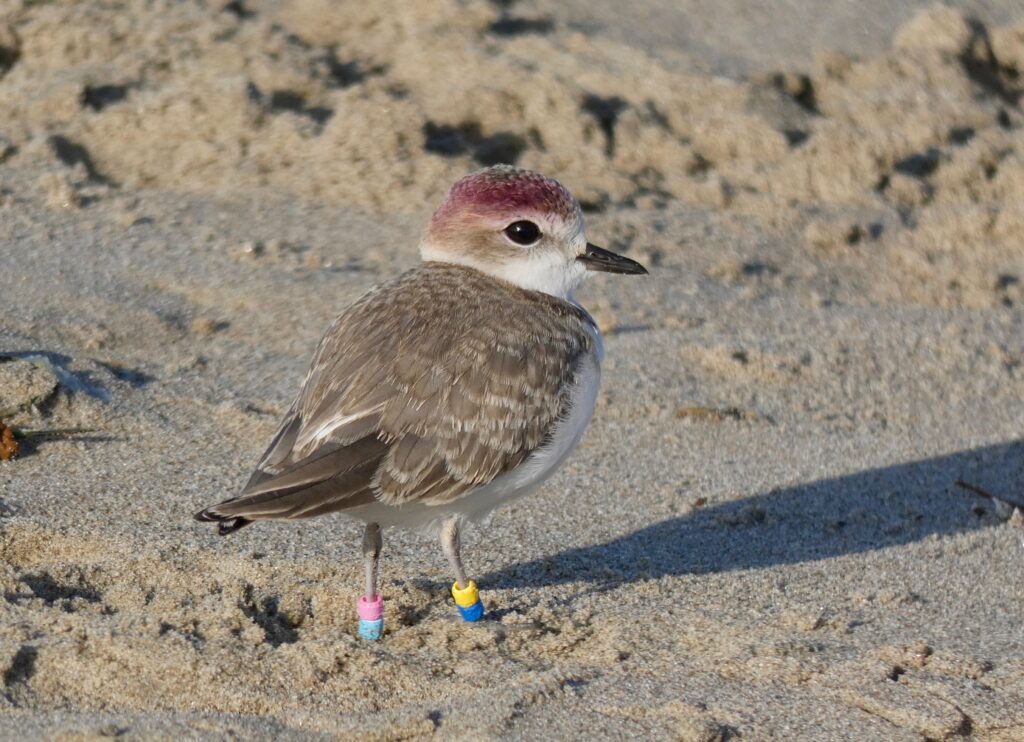

2020
Spring 2020: A pair of snowy plovers establishes a nest on Carpinteria State Beach east of the mouth of Carpinteria Creek. The nest is discovered by State Park biologist April Randol. Unfortunately the nest is destroyed by an extreme high tide before the eggs hatch. This is the first known nesting attempt at this location since 1960.
April later included photos of the installation of the wire exclosure, the nest, and the banded parent bird in a paper on snowy plover and least tern nesting success; see Nesting Neighbors. (Photos below courtesy of California State Parks/Heidi Ortloff.) The female of the pair is pa:yb, the same bird I saw the previous September in this location.

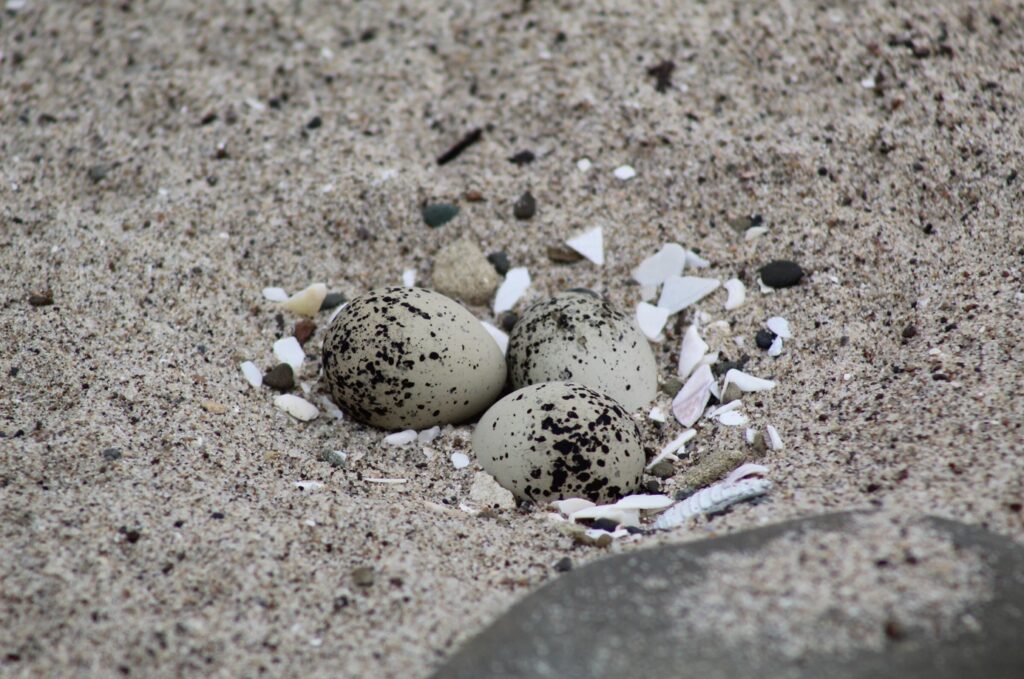

2021
Friday, May 7, 2021: According to State Park Interpreter Heidi Ortloff there are no plovers nesting on the beach as of this date.
Saturday, May 8 – Sunday, May 9, 2021: A pair of snowy plovers establishes a nest. Again, the nest is discovered by State Park biologist April Randol, who puts up a protective rope line around the area and an anti-predator “exclosure” cage over the nest itself.
Monday, May 10, 2021: State Beach employees and lifeguards are informed about the nest via email.
Tuesday, May 18, 2021: While birdwatching along the beach I notice the rope fencing and exclosure, and photograph the adult female plover incubating on the nest. (eBird list)
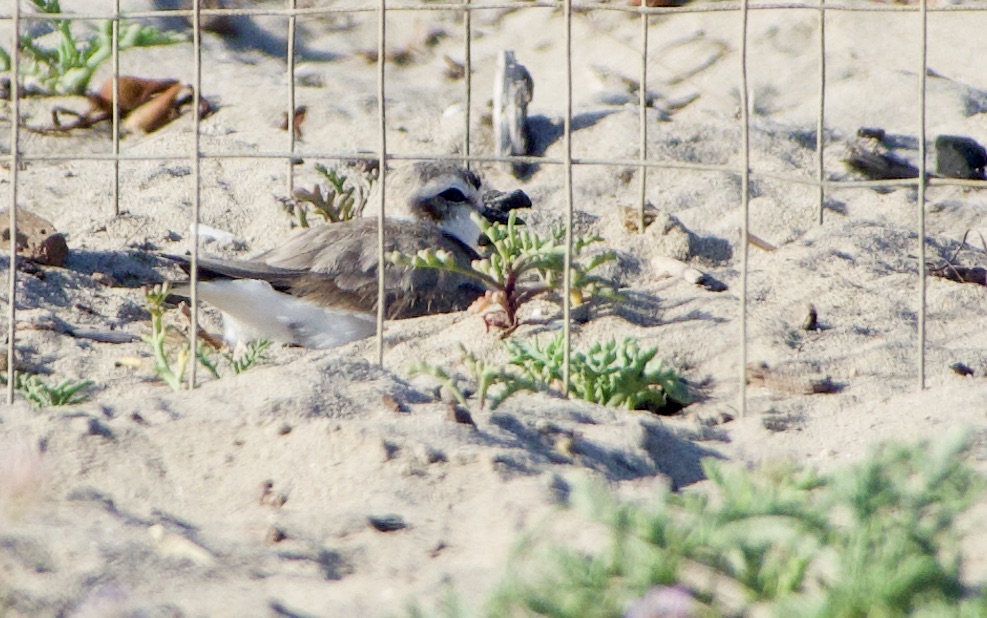
Monday, May 24, 2021: I revisit the site and photograph the female on the nest and the male nearby. I put out an appeal for people join me in a volunteer “plover watch” to monitor the nest site and do public outreach. (eBird list)

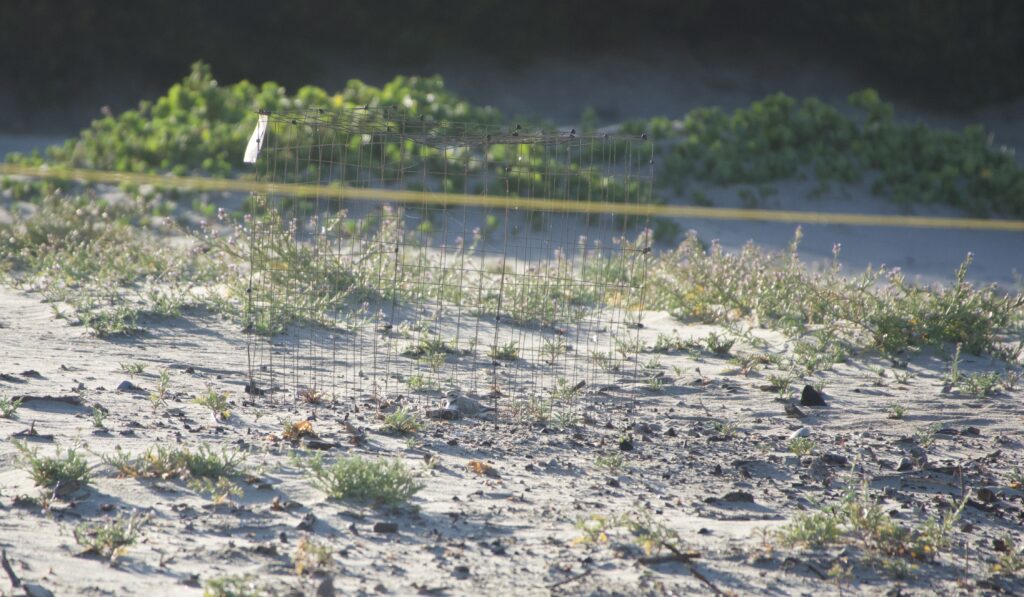
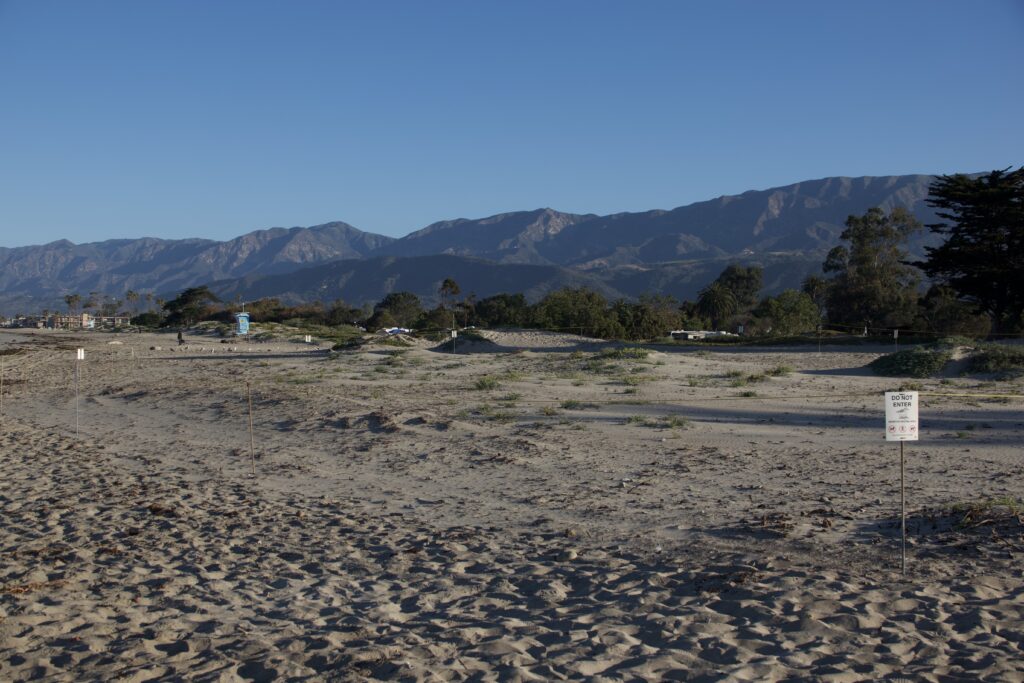
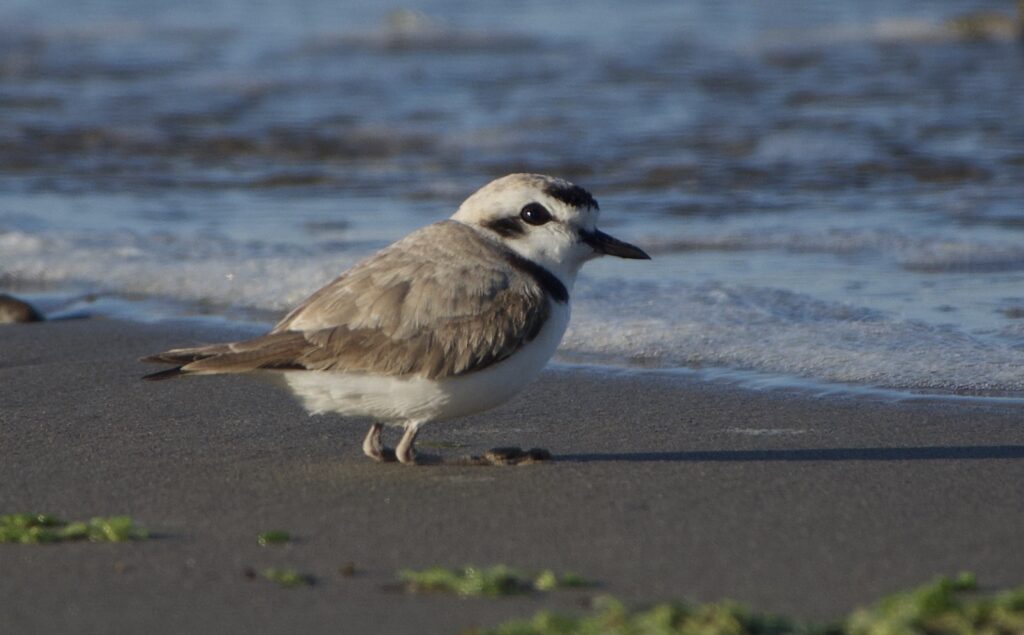
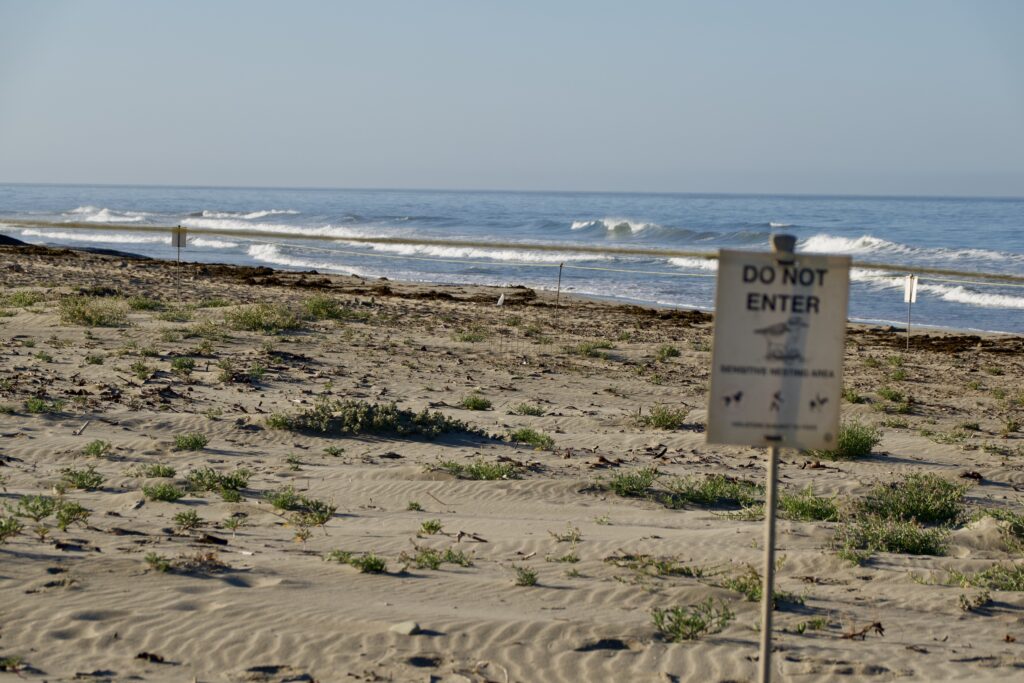
Tuesday, May 25, 2021: I visit the site and inadvertently flush the female plover from the nest. Photos show three eggs in the nest and color bands on the female bird; the bands are faded, but subsequent better photos by Bill Crowe reveal the band combination to be brown over white (left), red over blue (right) (nw:rb). The bird was banded as a chick in 2013 at the VAFB Surf North site, just south of Ocean Beach Park near Lompoc. (See screenshot below from Monitoring and Management of the Endangered California Least Tern and the Threatened Western Snowy Plover at Vandenberg Air Force Base, 2016.) (eBird list)
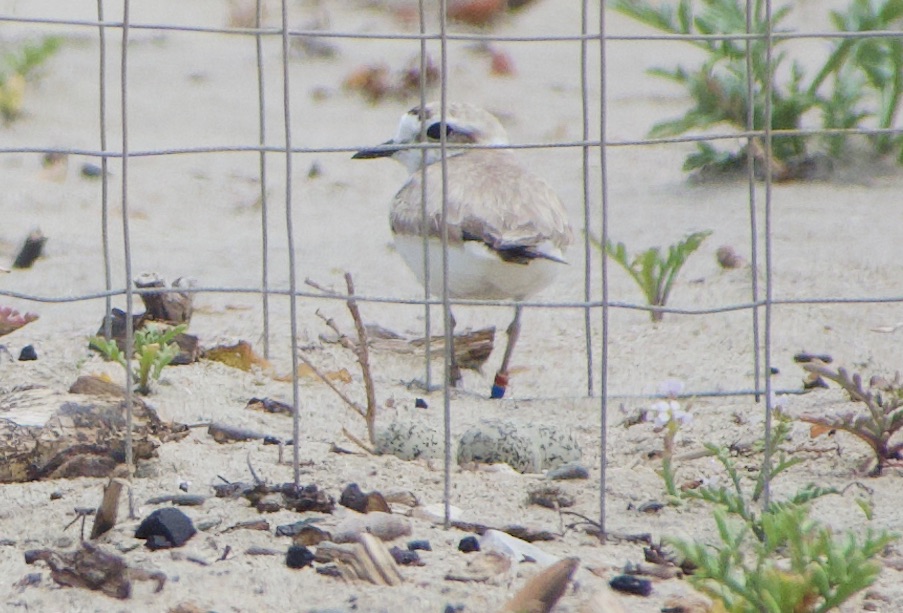
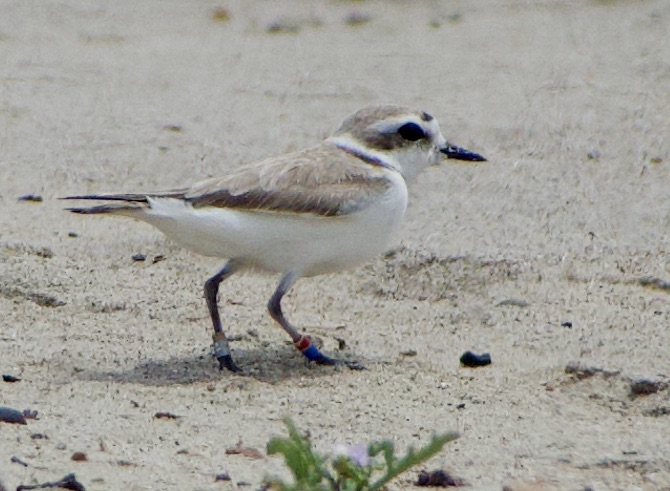

Wednesday, May 26, 2021: I photograph the female on and off the nest, and the male on the beach nearby. (eBird list)
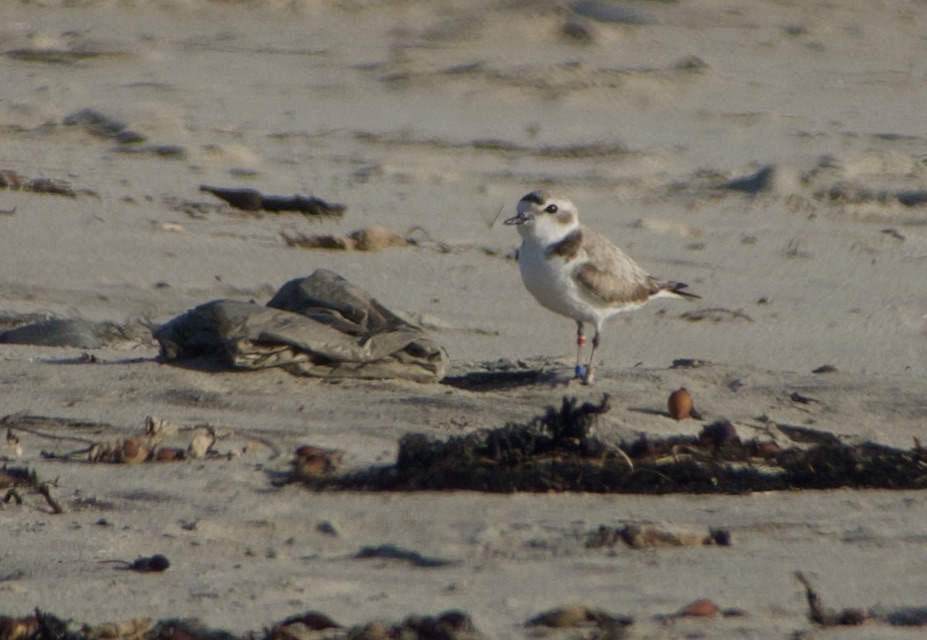
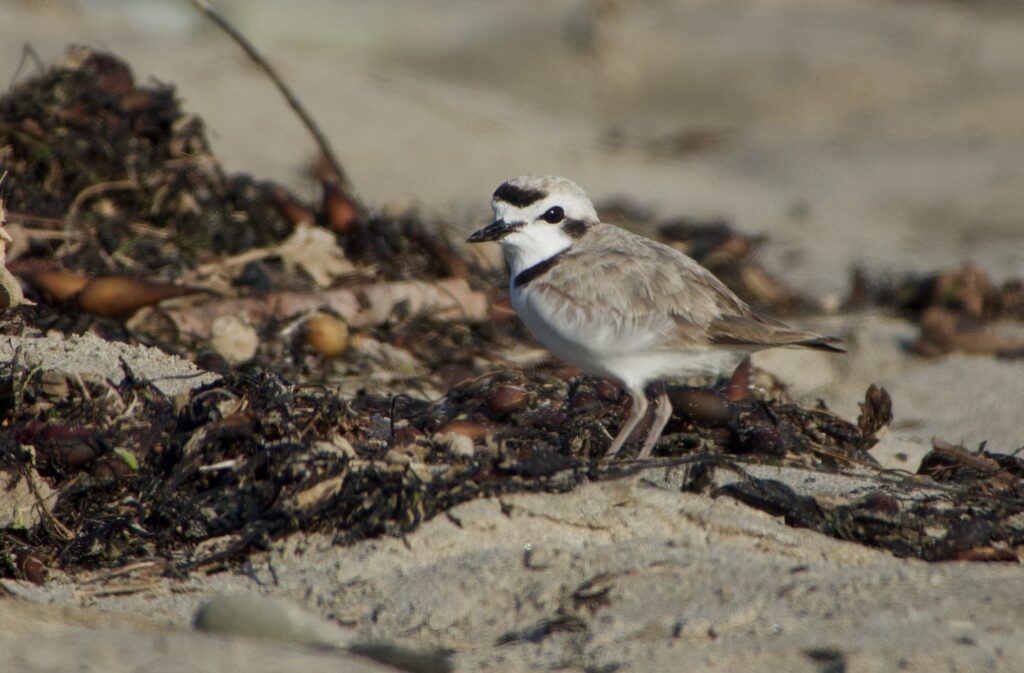
Thursday, May 27, 2021: I photograph the female on the nest and the male feeding in the wrack. (eBird list)
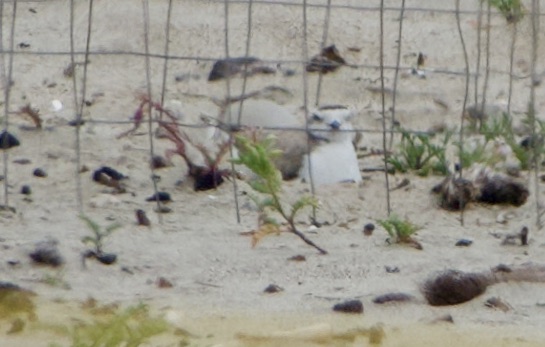
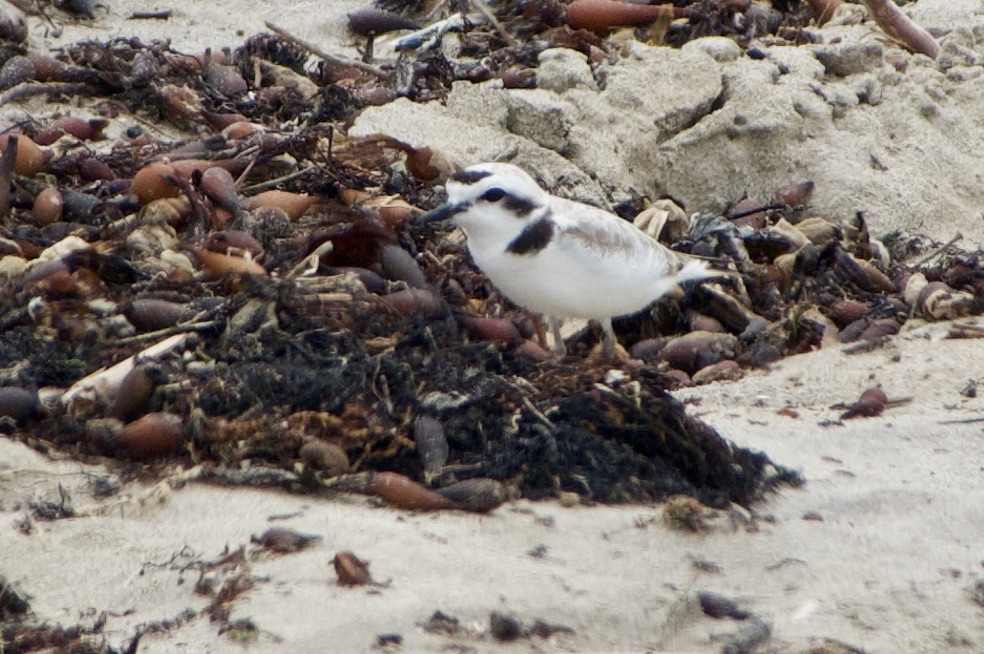
That evening we talk about the plovers with special guest Jessica Nielsen at the monthly Carpinteria Birdwatchers Zoom meeting.
Friday, May 28, 2021: I photograph the male and female bird again. (eBird list)
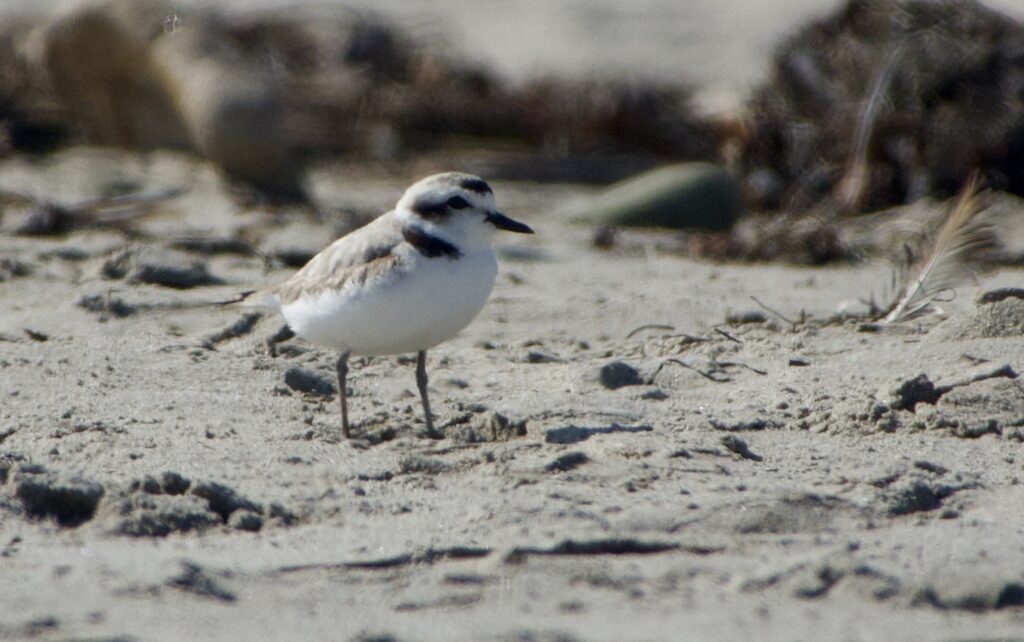
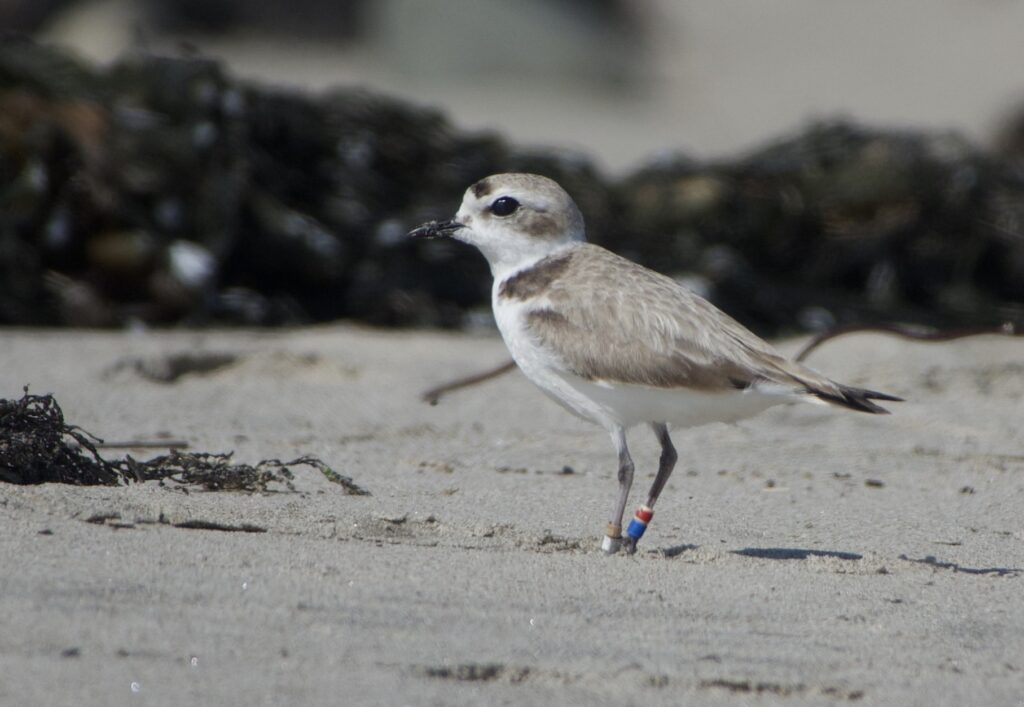
Saturday, May 29, 2021: I observe both birds. (eBird list)
Sunday, May 30, 2021: With big Memorial Day crowds in the campground and on the beach, the female bird leaves the nest in the afternoon and stays on the less-crowded beach near the mouth of Carpinteria Creek while the male incubates. (eBird list)
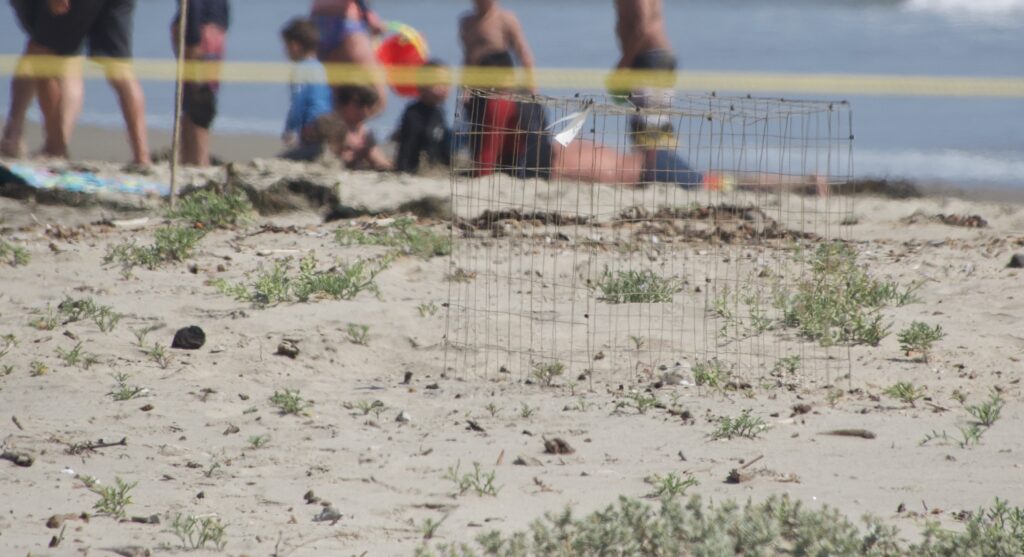
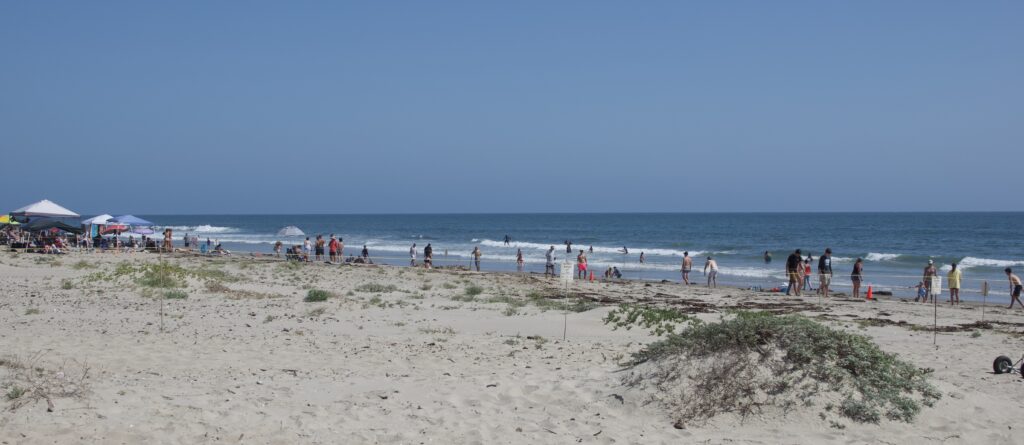
Monday, May 31, 2021: Crowds are lighter than on Sunday. I observe the female bird mostly handling incubation duties, though she’s off the nest a fair amount due to disturbances. (eBird list)
Tuesday, June 1, 2021: I photograph the male on the beach and the female on the nest. (eBird list)
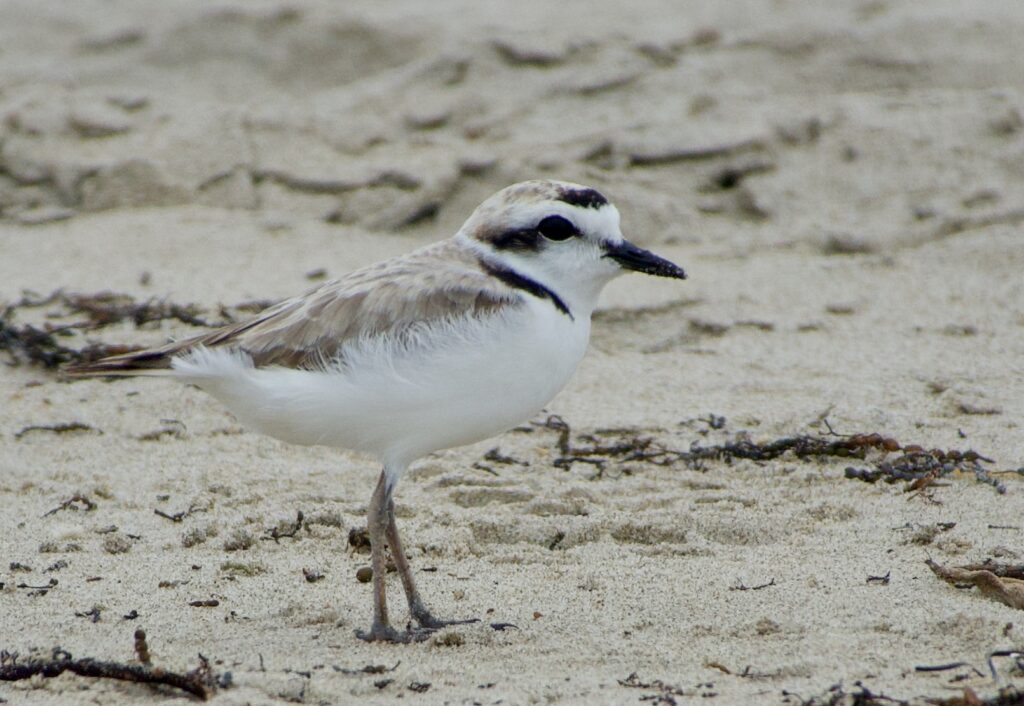
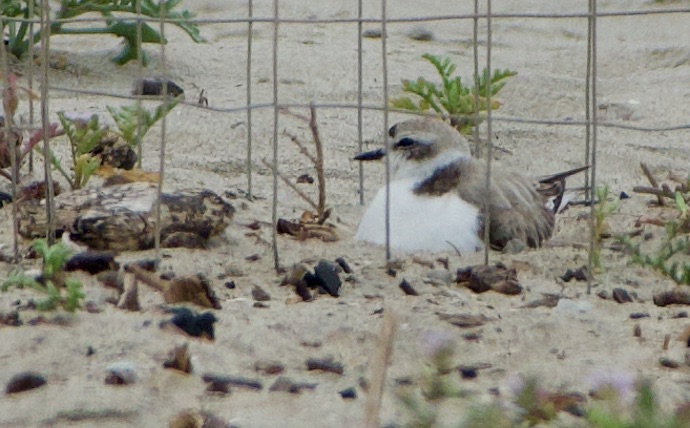
Wednesday, June 2, 2021: I photograph the male on the beach and the female on the nest. (eBird list)
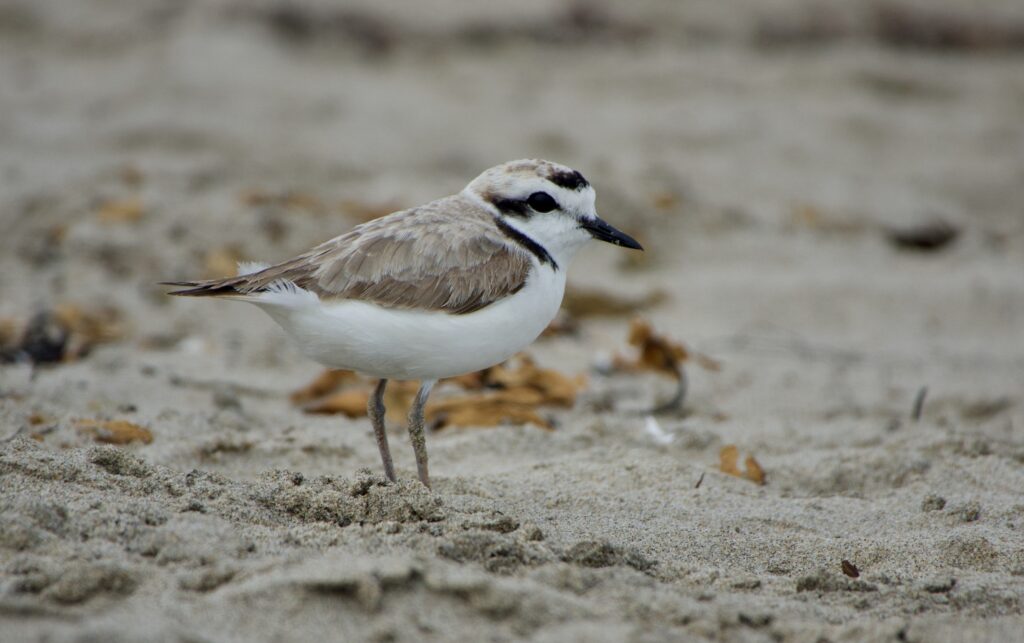

Thursday, June 3, 2021: I photograph the female off the nest and tire tracks past the roped-off area. In subsequent emails by Nancy Baron and others, concerns are raised about the State Park rangers and lifeguards driving past the nest area, where plover chicks will soon be highly vulnerable to injury by vehicles. State Park representatives take steps to communicate with relevant parties about plover safety precautions. (eBird list)
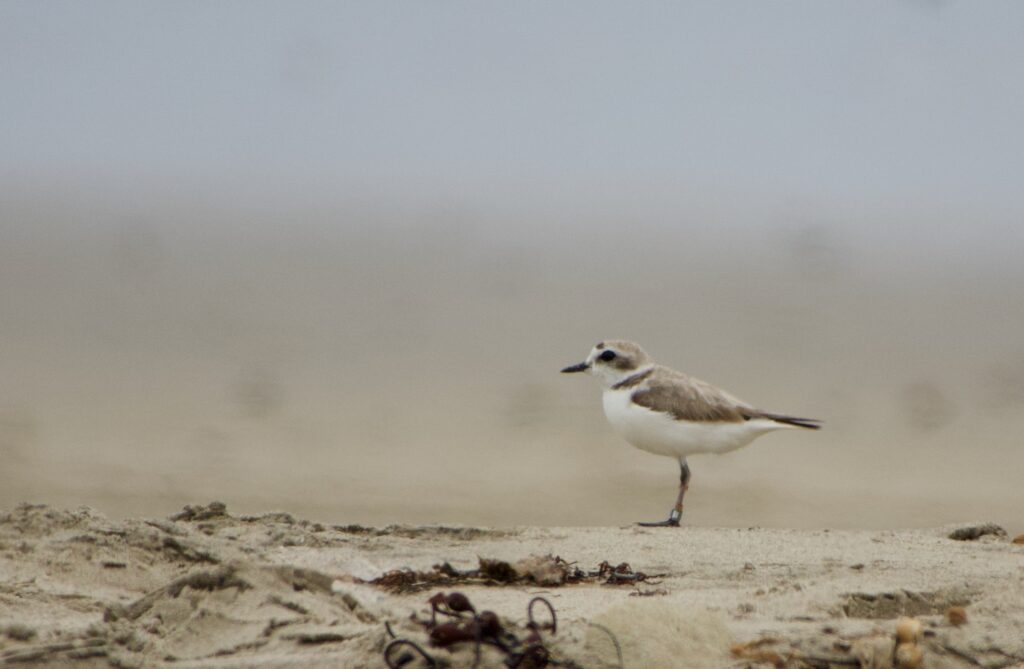

Sunday, June 6, 2021: After being out of town for a few days, on Sunday I return and photograph a nearby bench with a view of the plover nest for Joan Lentz, who has health-related mobility limitations and had asked me about access. I also photograph the female bird on the nest. (eBird list)
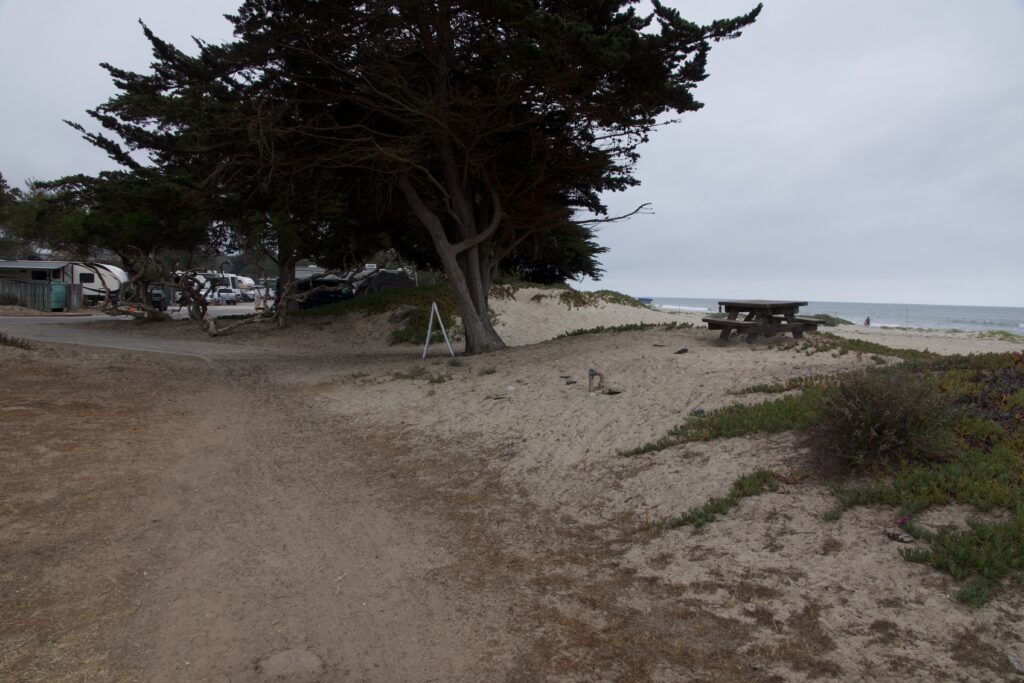
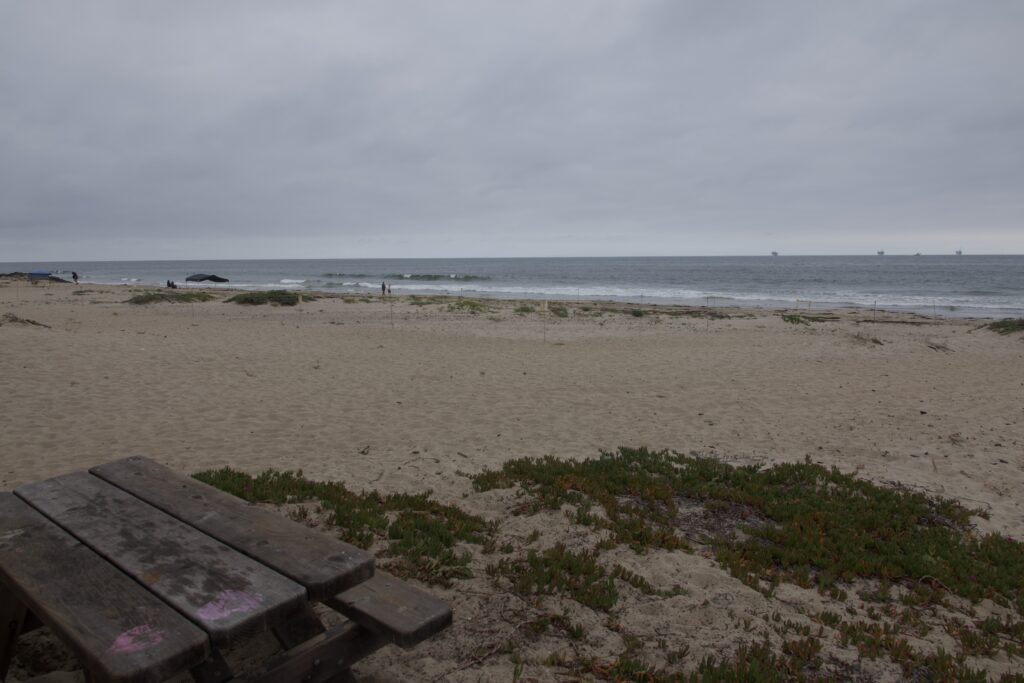
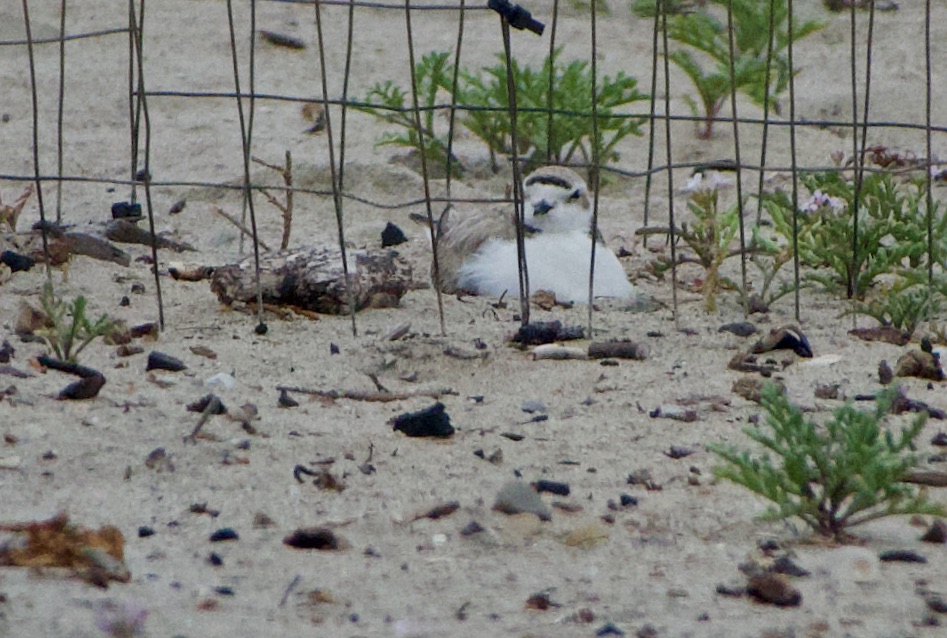
Monday, June 7, 2021: Joan visits the plovers (eBird list) and subsequently shares a photo of her visit with me; I photograph the female bird on and off the nest. (eBird list)
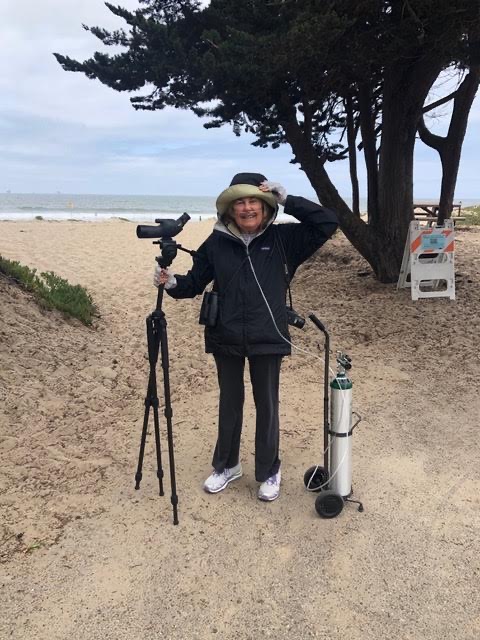

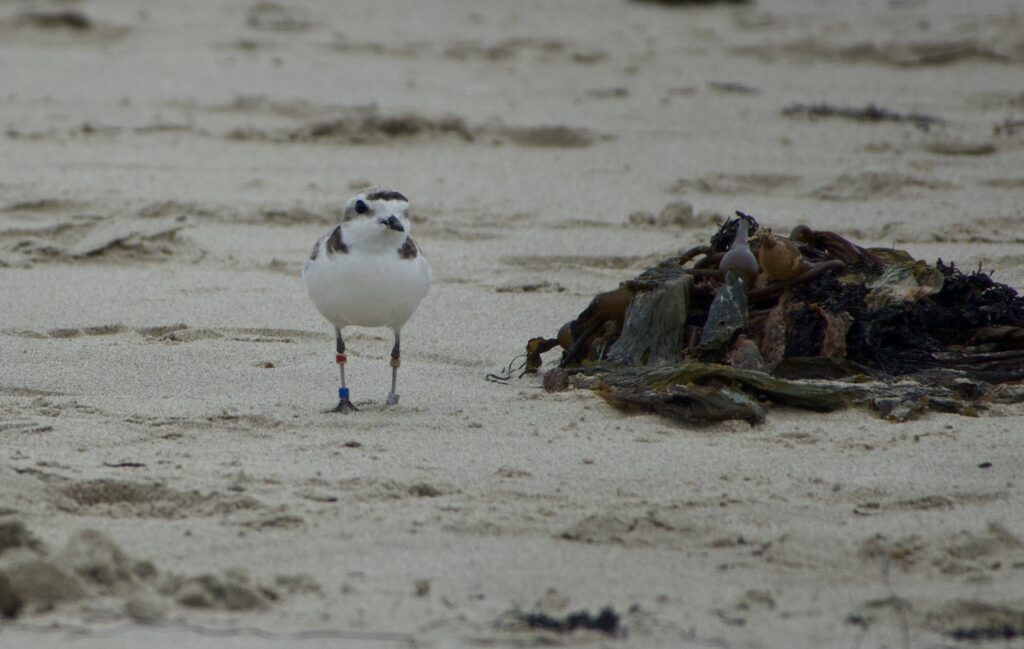
Tuesday, June 8, 2021: At 9 a.m. I photograph the female bird on the nest and the male bird feeding in the nearby wrack. (eBird list)

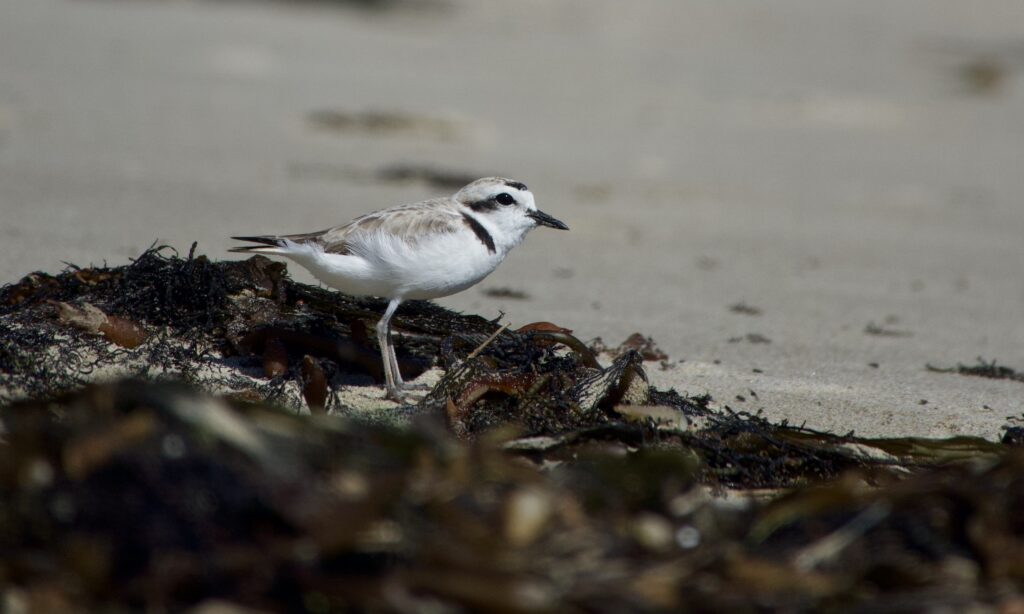
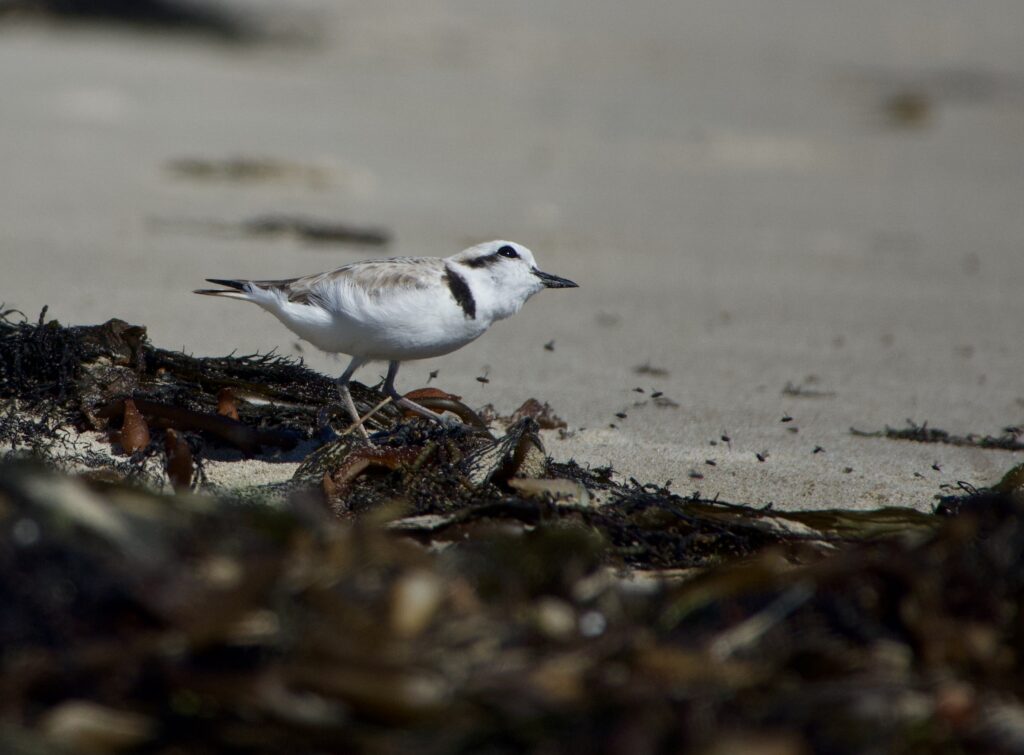
In late afternoon I get a text from Tom Beland that the eggs have hatched. At 7:45 p.m. I arrive and photograph excited birders, the female bird doing a distraction display, and the male bird brooding three chicks. (eBird list)
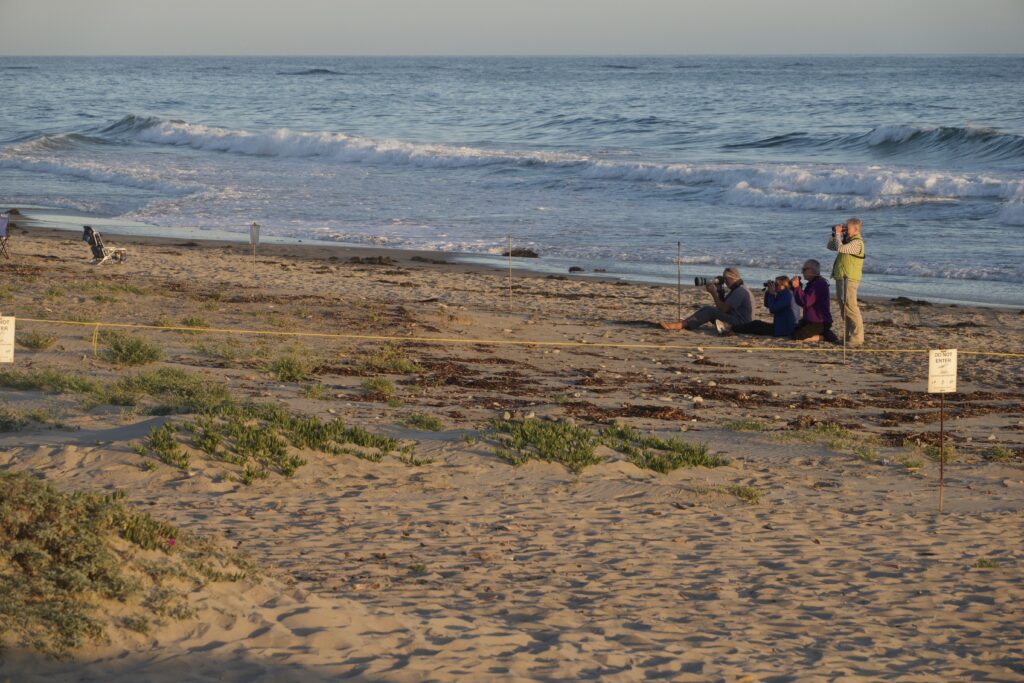
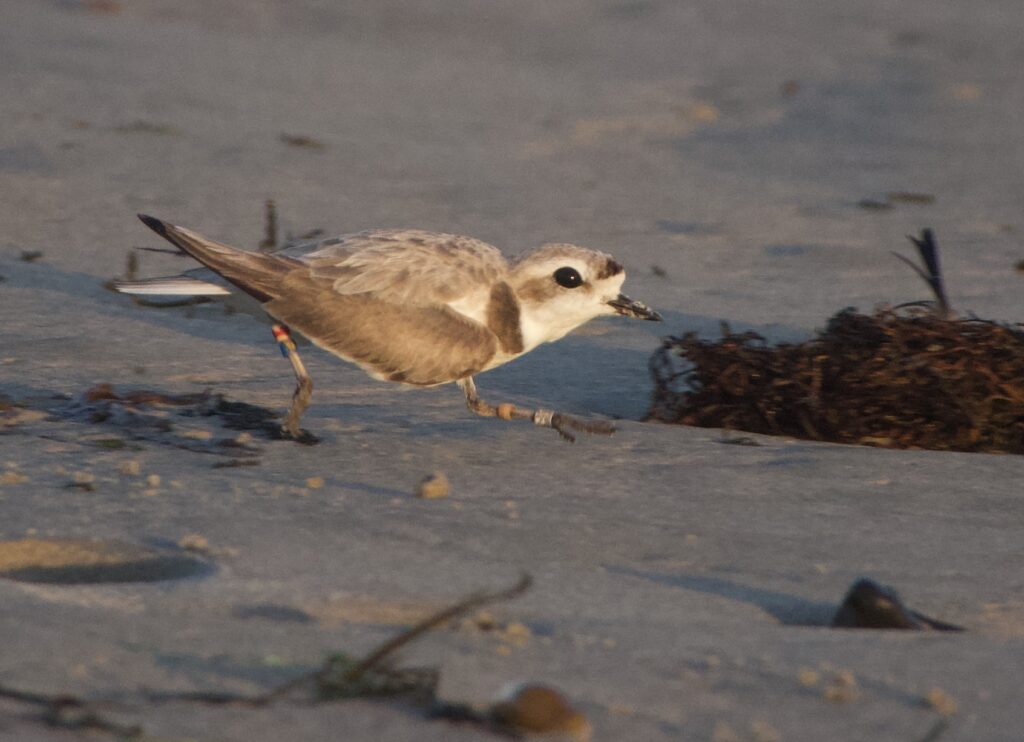
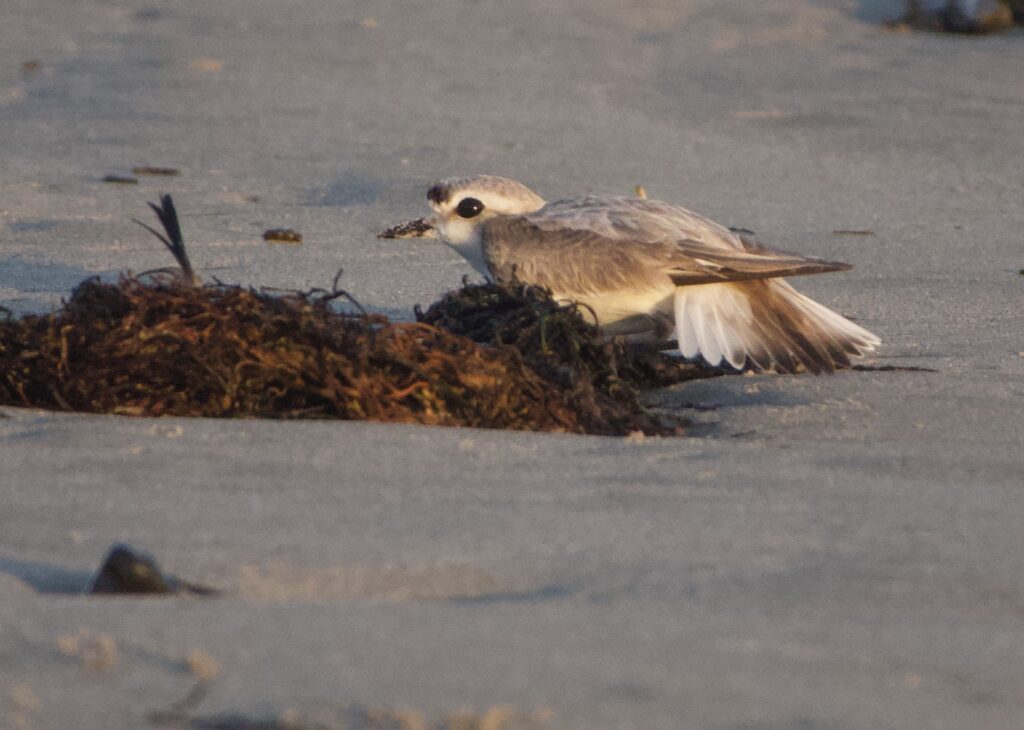
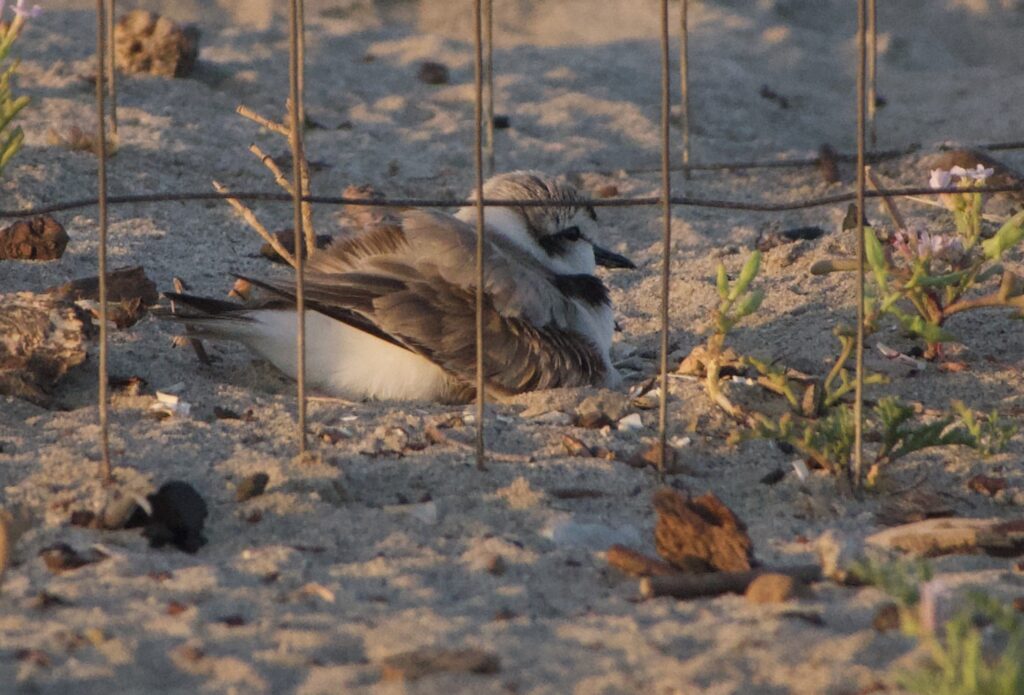
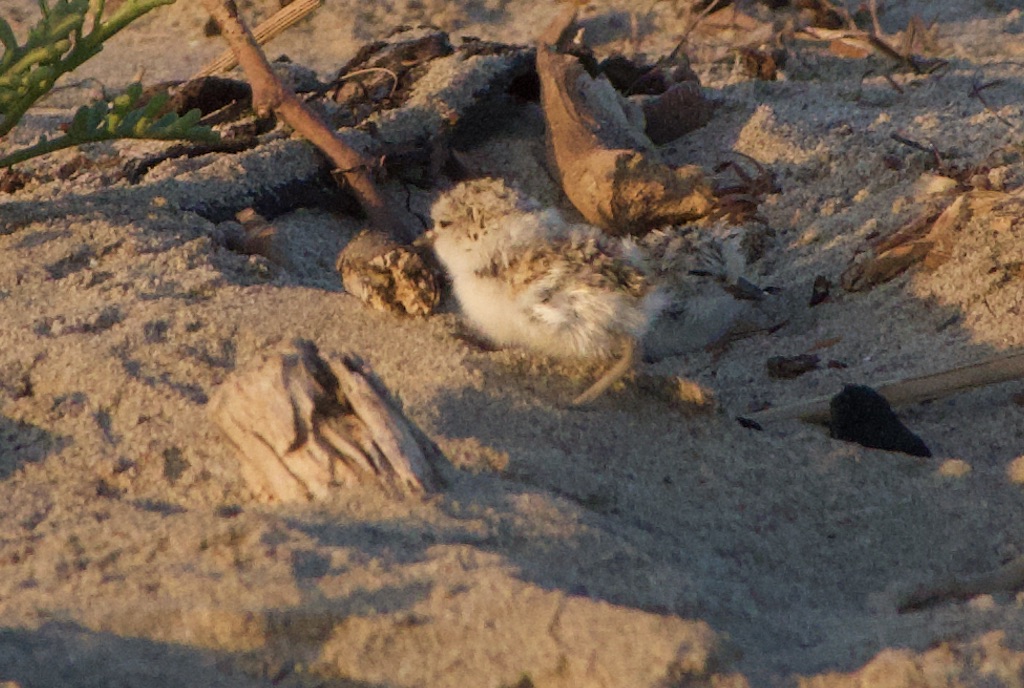

Wednesday, June 9, 2021: I arrive in the morning to find Chuck Graham already on site taking photos of the male bird and three chicks; the female bird is feeding on the beach nearby. I subsequently learn that visitors throughout the day do not see the female bird, so she apparently left (which is typical after hatching) at some point after I last saw her at 7 a.m. (eBird list)
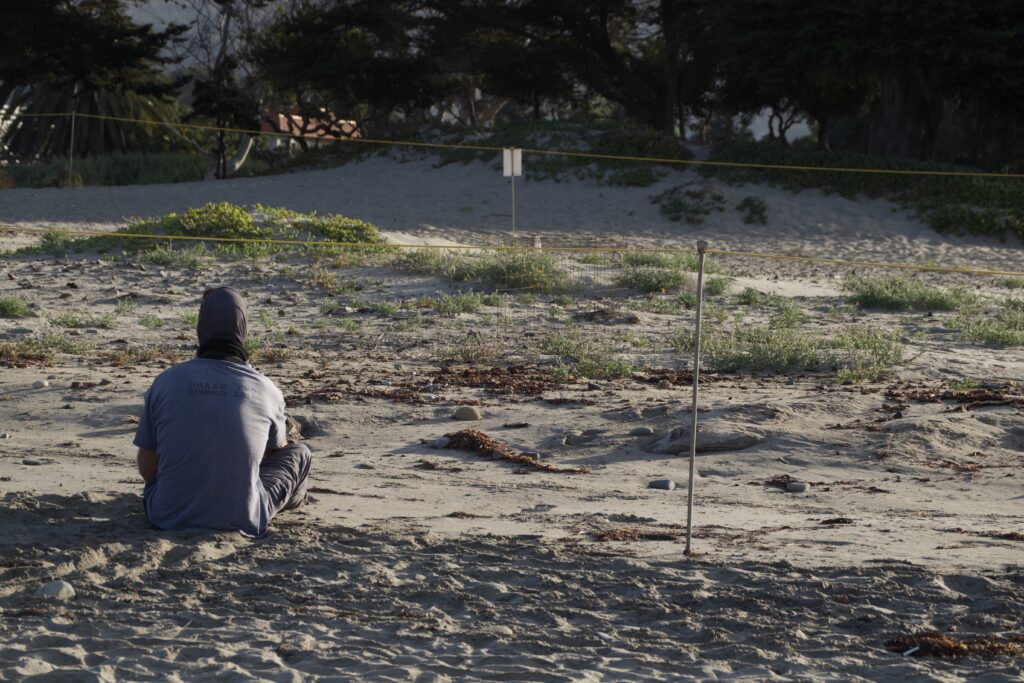
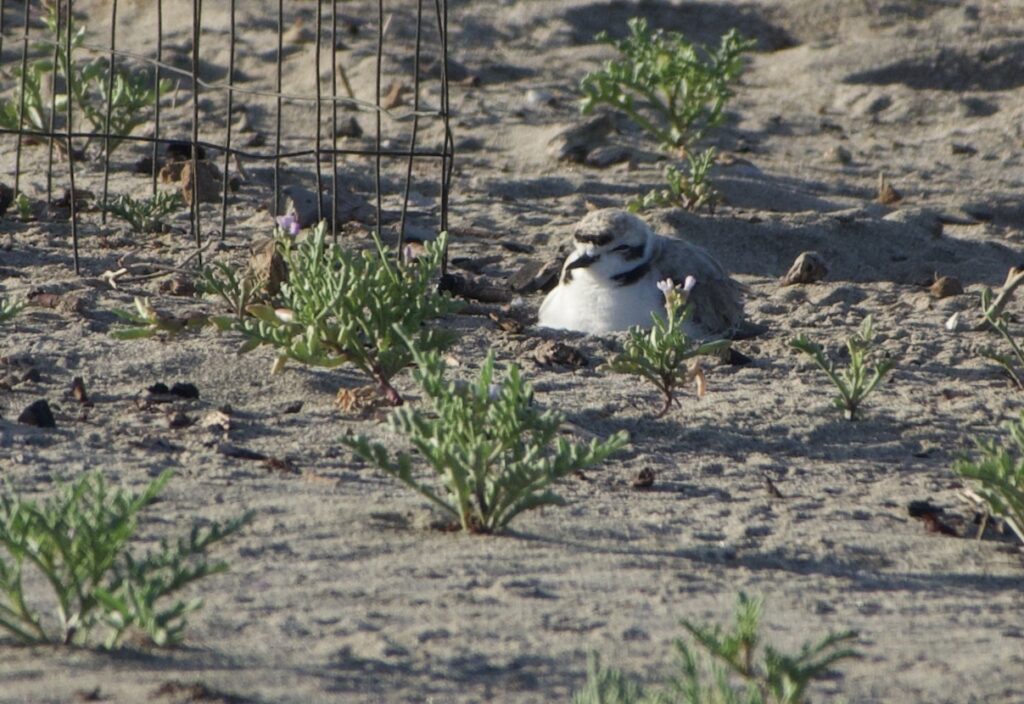
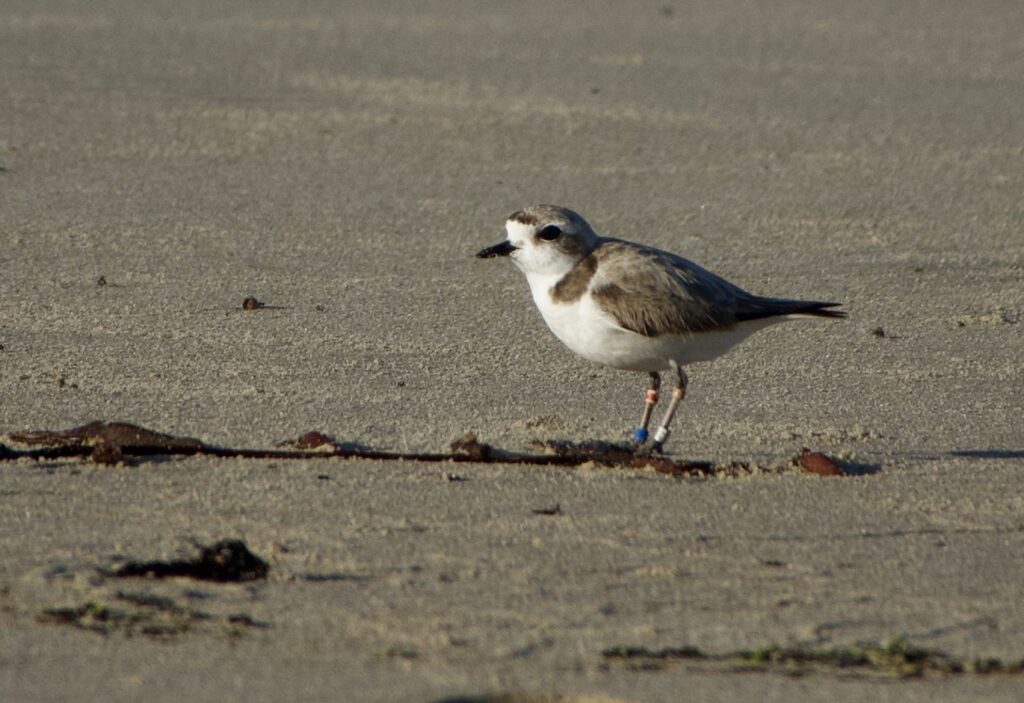
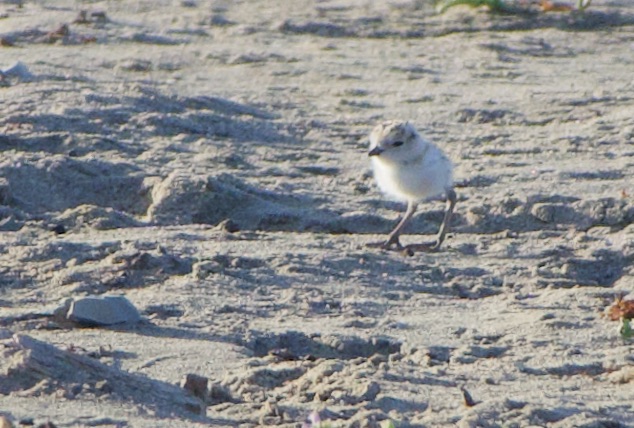
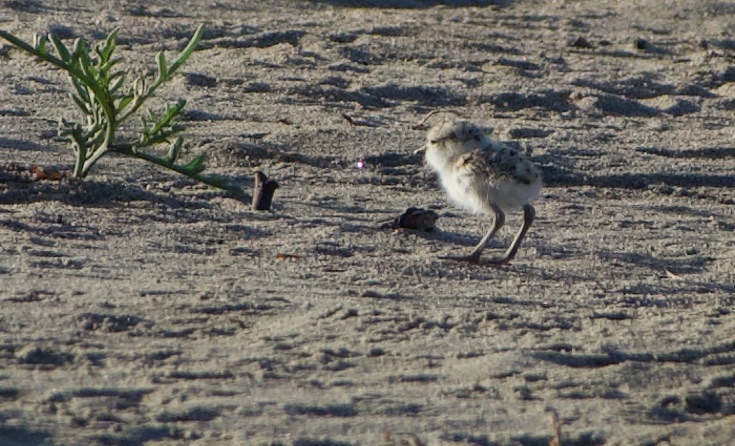
During my visit I also shoot this video showing one of the chicks taking some awkward steps and then burrowing under the adult male to get warm, and then the adult female foraging.
Thursday, June 10, 2021: I photograph the male and three chicks at 9:30 a.m. (eBird list)
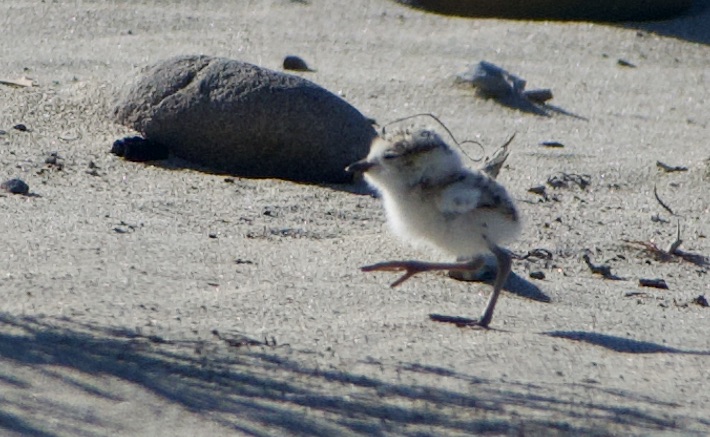
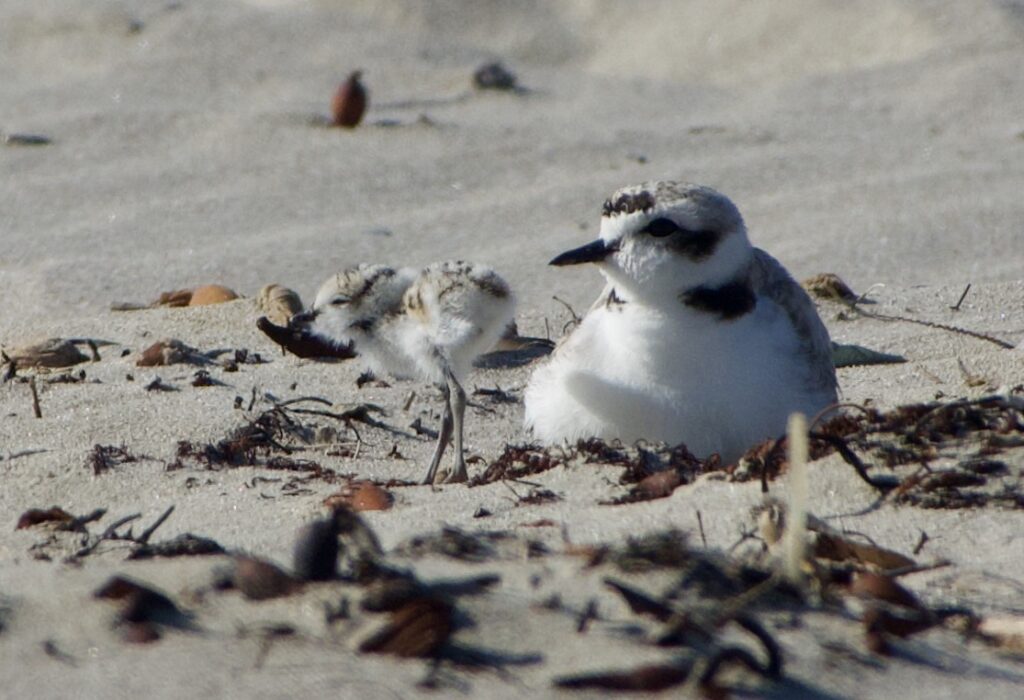
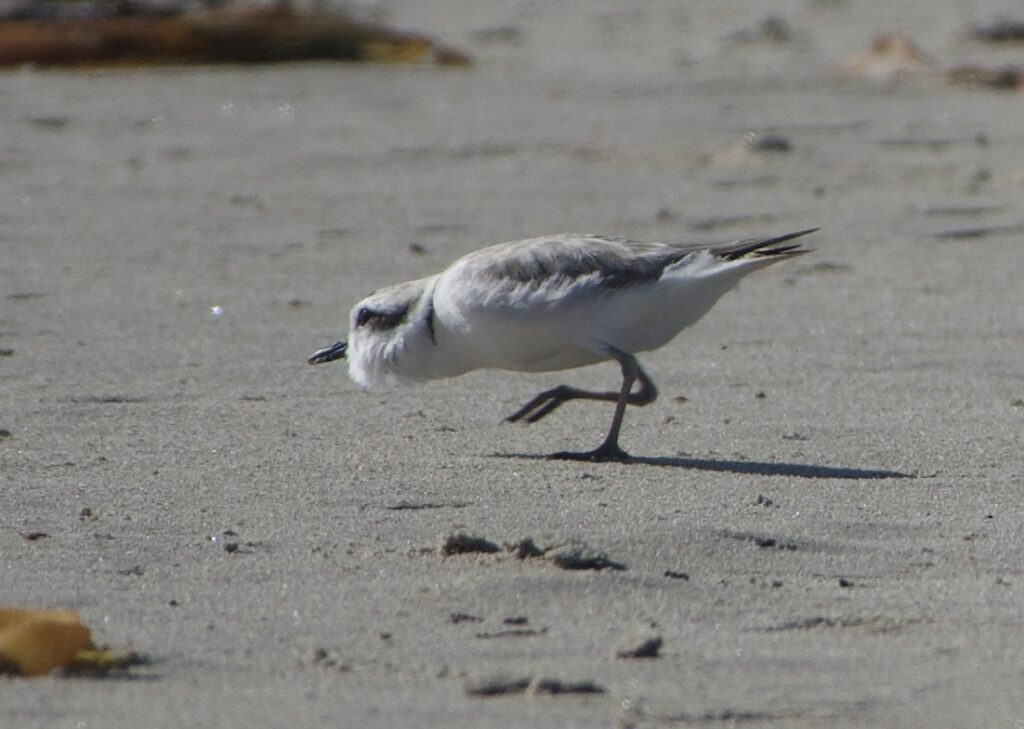
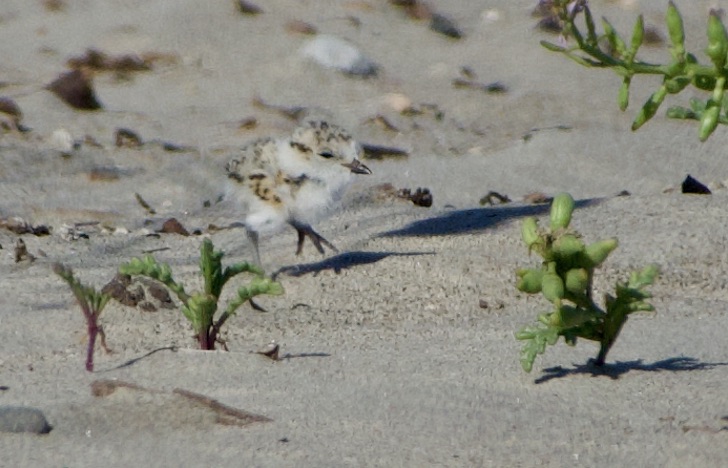
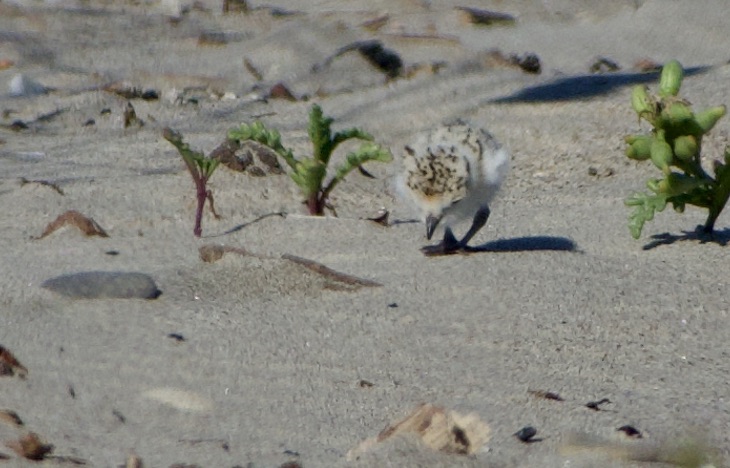
Friday, June 11, 2021: I photograph the male and two chicks at 8:30 a.m. Neither I nor State Park ranger Dave Wilson, who was on site, see a third chick, leading me to worry it has been lost. Later, though, I hear that the third chick was seen by multiple observers later that morning. State Park district biologist Brooke Sheridan sends an email in early afternoon confirming that all three chicks were seen as late as noon, and that “we have extended a temporary closed area directly in front of and to the sides of the original fenced area with cones to provide a larger buffer for forage, cover, and general space.” Later, Tom Beland shares with me that in conversation with Brooke he was told that State Park rangers are scheduled to monitor the plovers over the weekend and throughout next week.(eBird list)
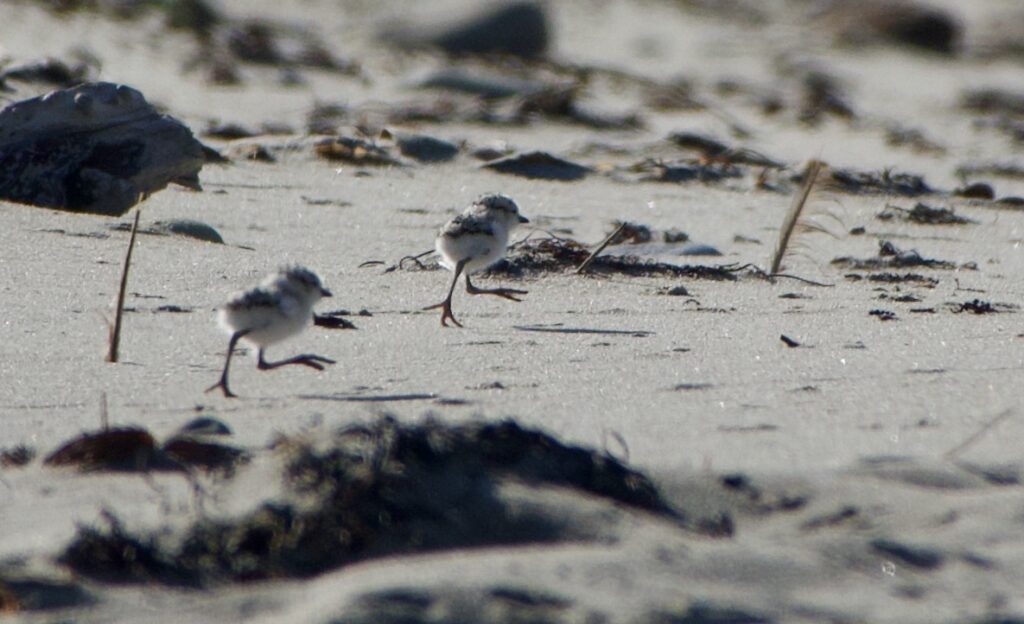
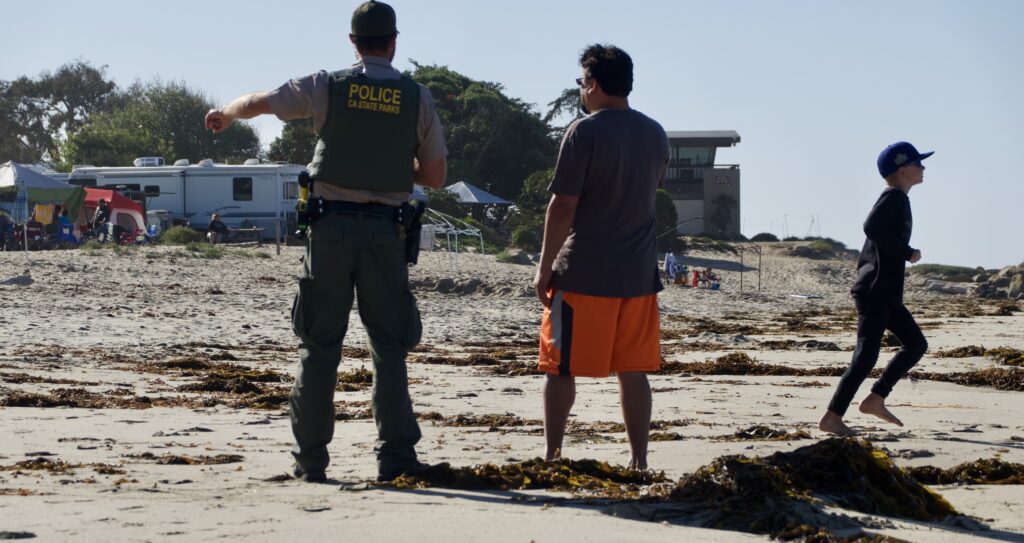
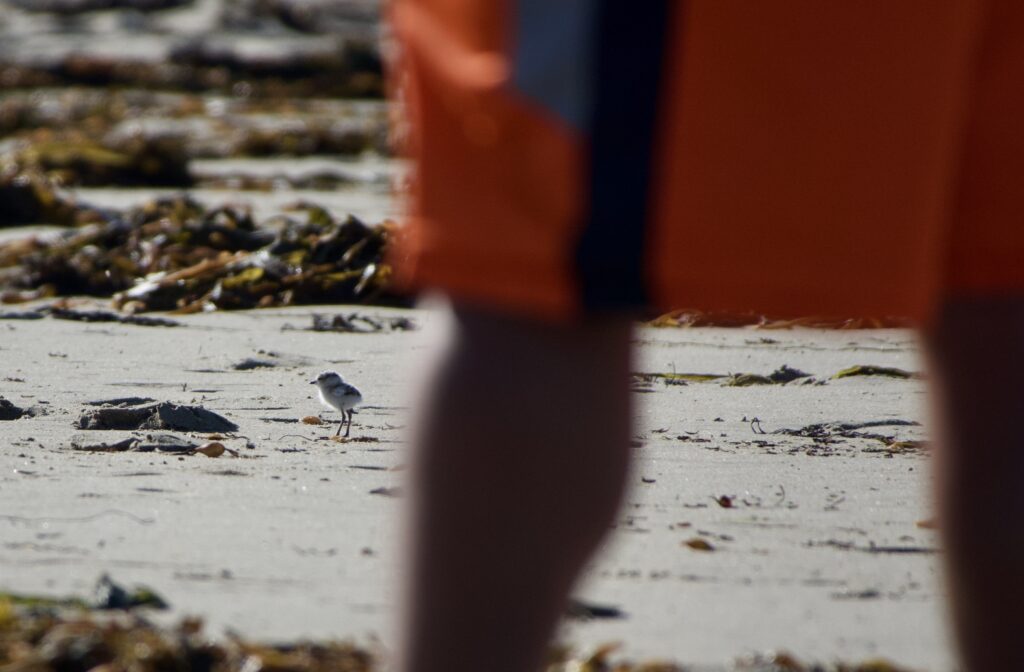
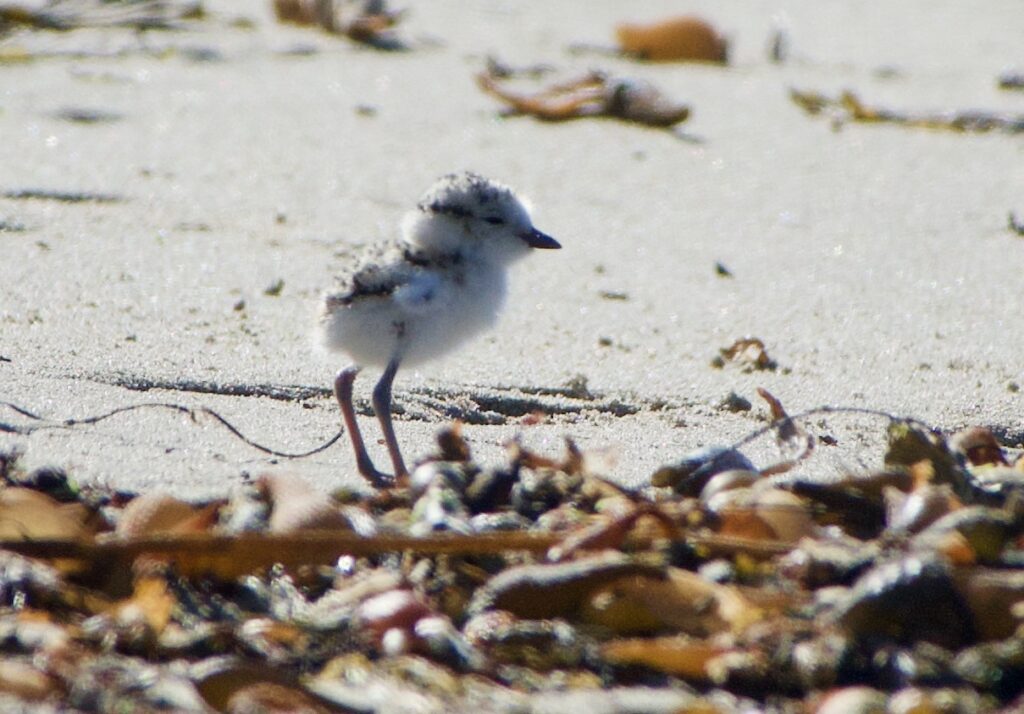
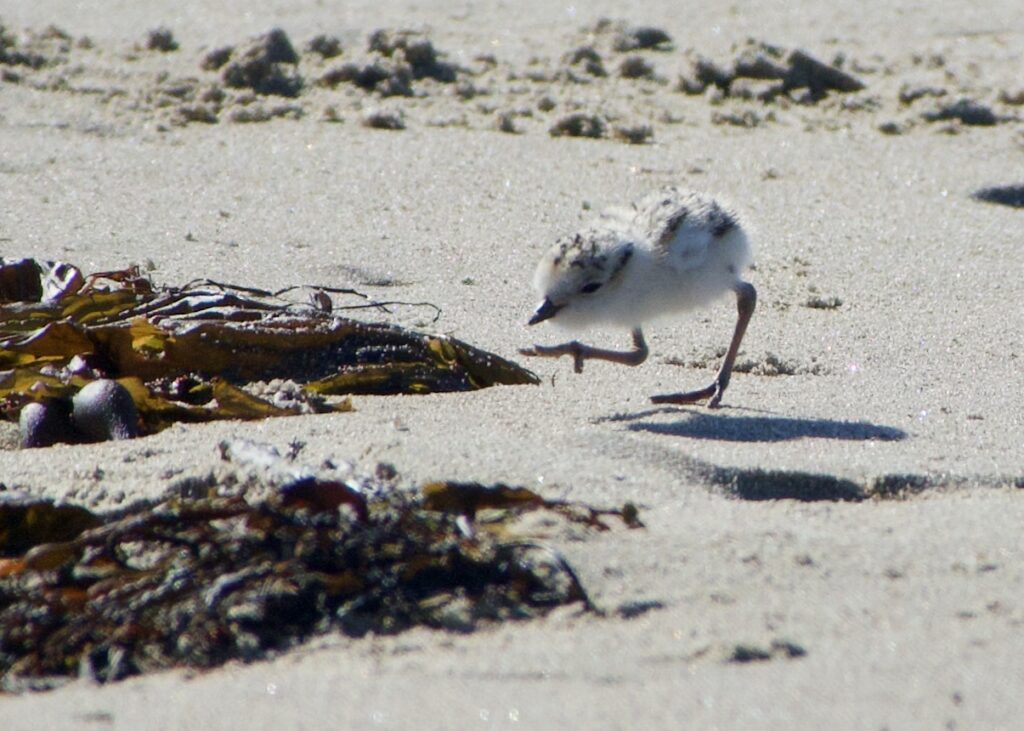
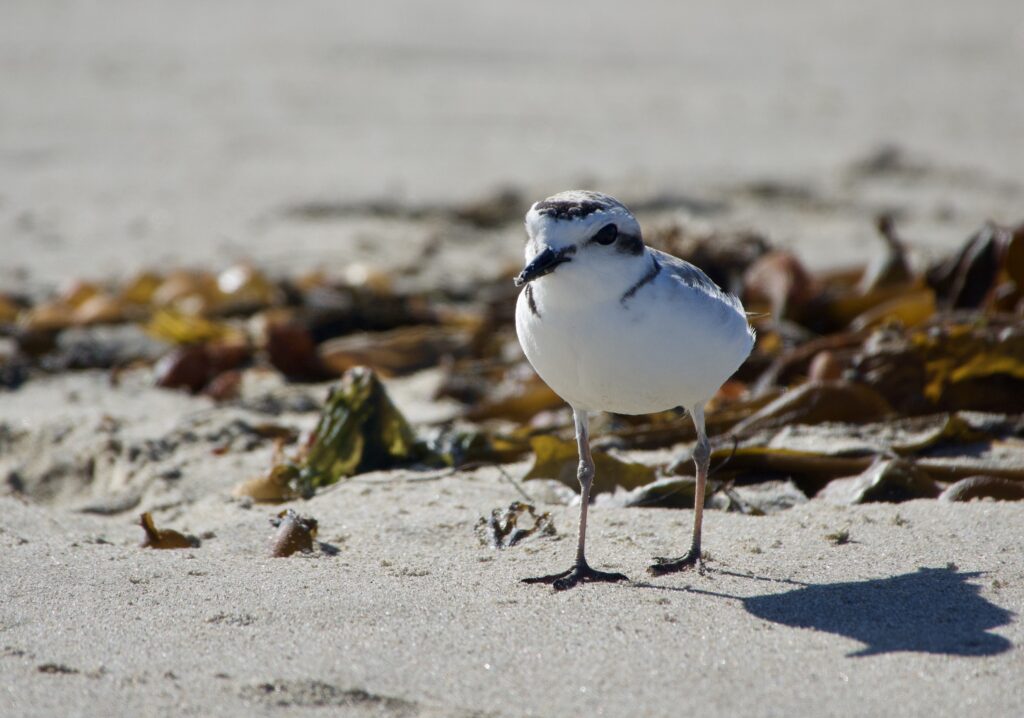
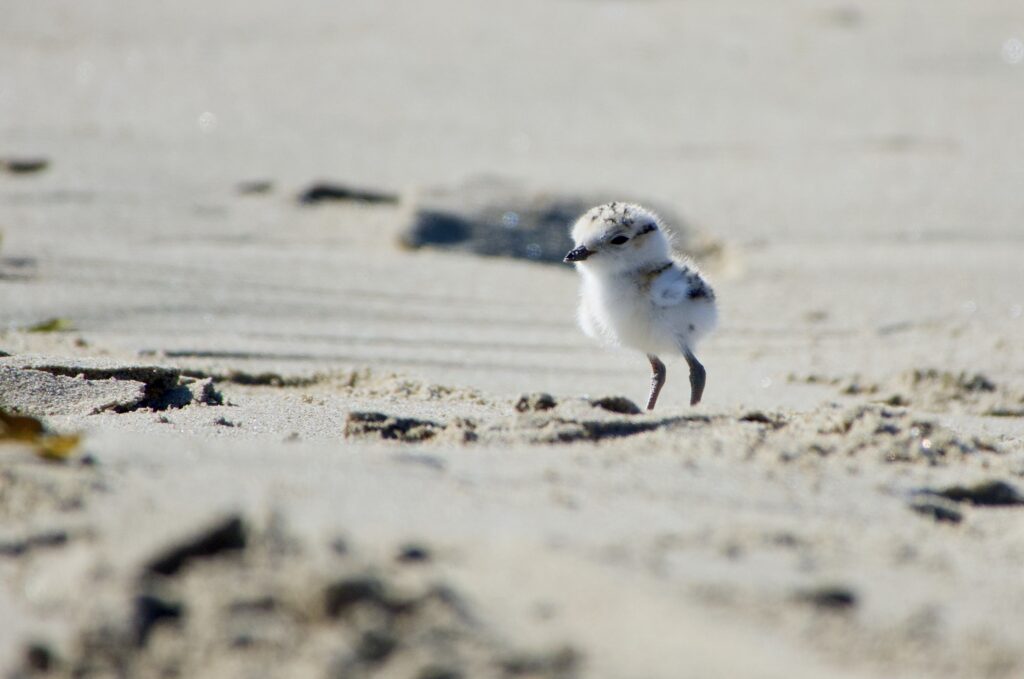
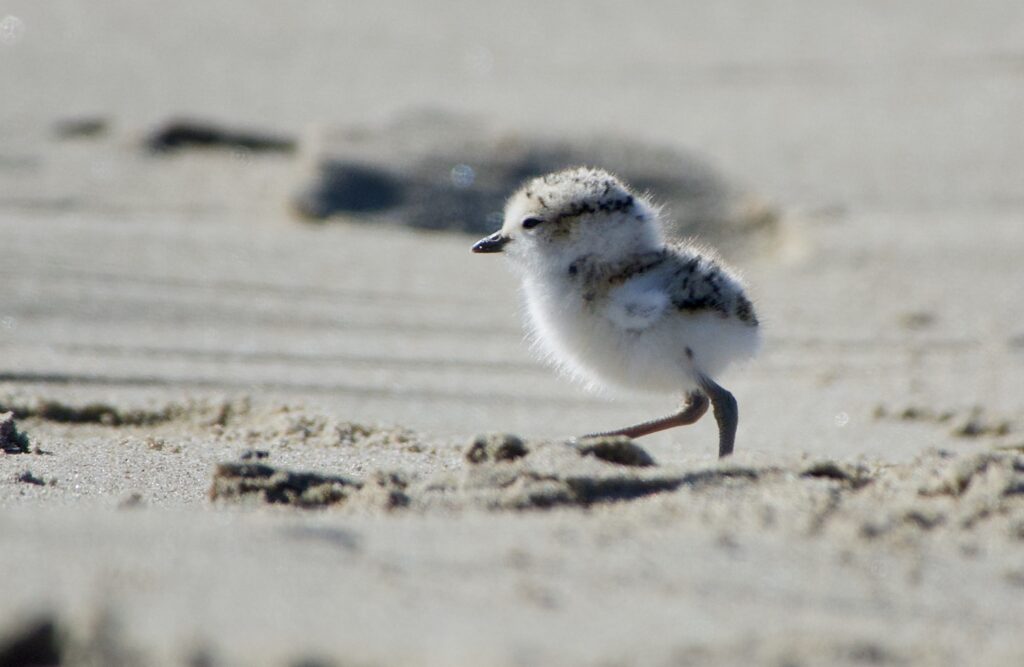
At 5:30 p.m. I visit again and take photos of the chicks foraging (all three of them this time) and the adult male keeping an eye on them. The extended buffer area has been taken down; no cones are present, and the State Beach people have left. (eBird list)

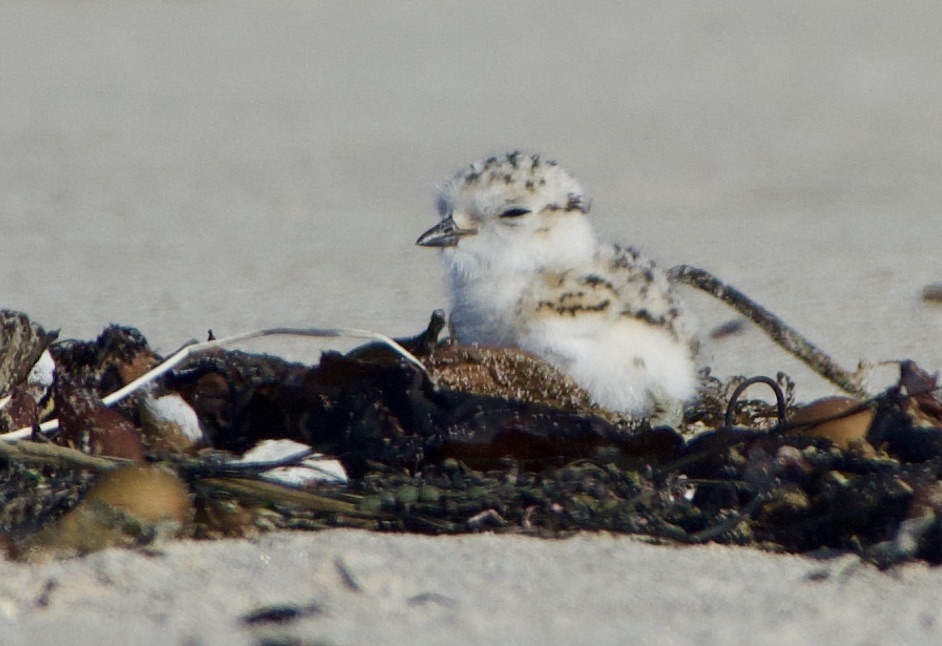
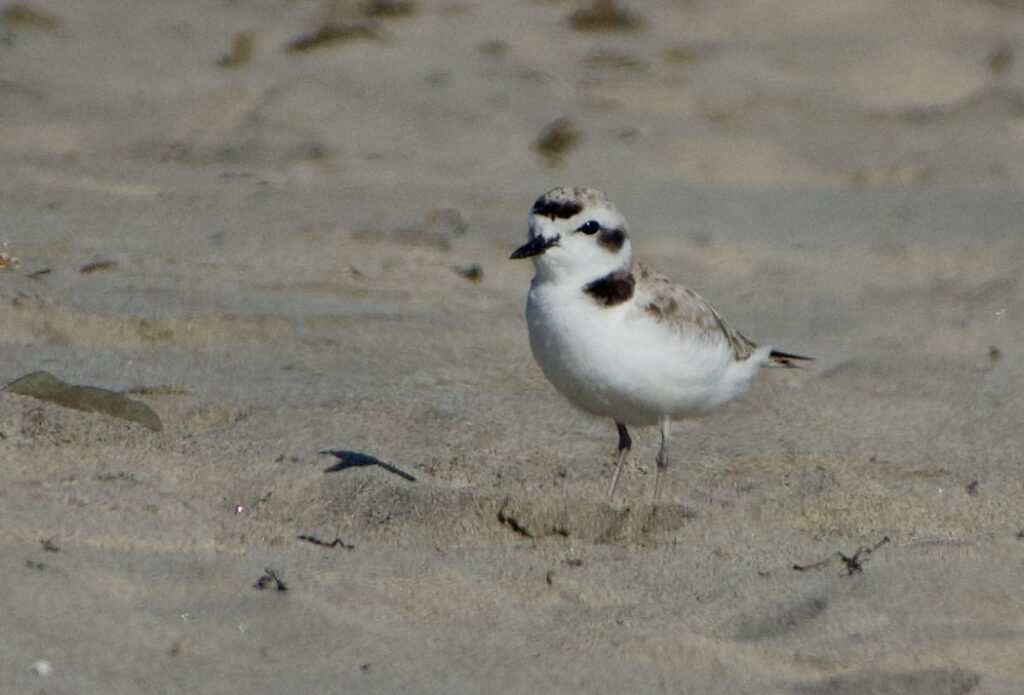
I also shoot this brief video of the chicks. (Apologies for the poor focus; I need to learn how to use my camera’s video feature.)
As I’m walking away a brief drama occurs and I stop to watch. I described it later in an email to Nancy Baron:
The gull situation does sound scary. Yesterday I was there around 5:45 p.m. The rangers and expanded cone area were gone, so it was just me and the plovers (and beachgoers/campers). At one point when the plovers were running around in the wrack in front of the middle of the roped-off area a family of campers with a mom and dad and a couple of young kids were playing down near the water, and a western gull was wandering around them. The dad playfully walked toward the gull, shooing it away. He continued to herd it along for about 50 feet; what he didn’t realize is that he was herding it right into the area where the plover chicks were.
It felt like one of those nightmares where you see something unfolding and can’t stop it. The dad lost interest and went back to his wife and kids. The male plover moved in and started trying to distract the gull. I’d been avoiding the area where the plovers were, but I power-walked straight into it and herded the gull myself, pushing it past the plovers and down the beach until it was 100 feet or so away from them. I gave it a dirty look before returning along the water’s edge.
I chatted with the family. They hadn’t heard about the plovers, though they’d seen them running around and were really interested. Eventually I got around to explaining about crow and gull predation. Joking, the mom said, “so if we see that we should chase them away, huh?” And I laughed and said, yeah, and it’s important to chase them AWAY from the plovers, ha ha ha.
I’m not sure if the dad even realized that he’d herded the gull toward the birds, and I didn’t mention it. They seemed genuinely into looking out for the plovers for the rest of their campground stay, though.
So. One crisis averted. 2,418 crises to go. 🙂
Saturday, June 12, 2021: I visit at 10 a.m. and take photos of the adult male and the three chicks, which seem to be getting better at finding food. (eBird list)
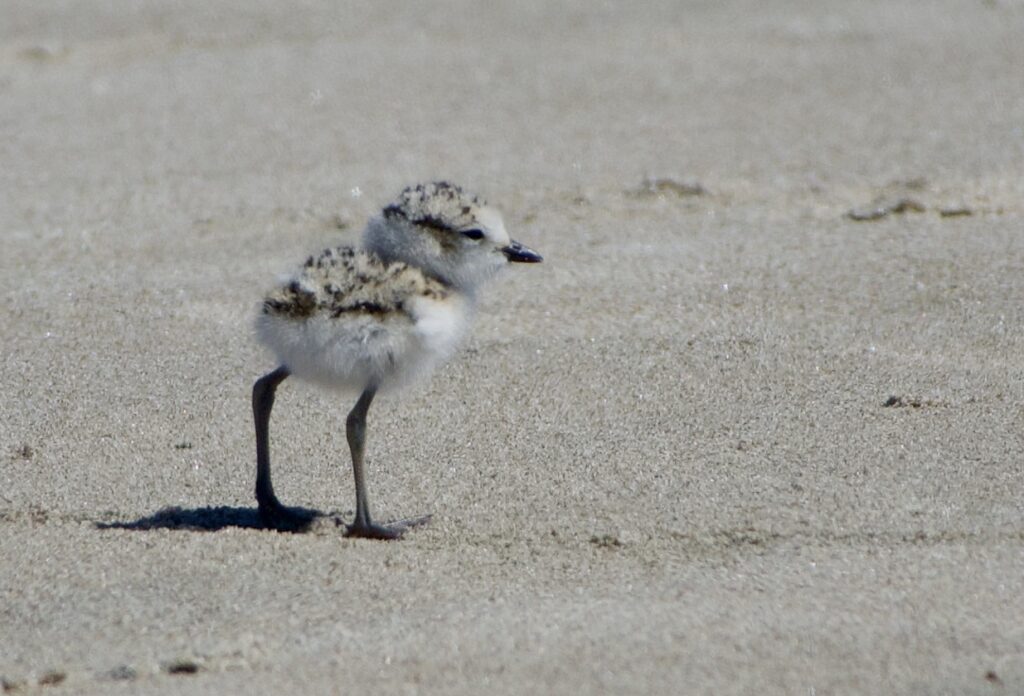
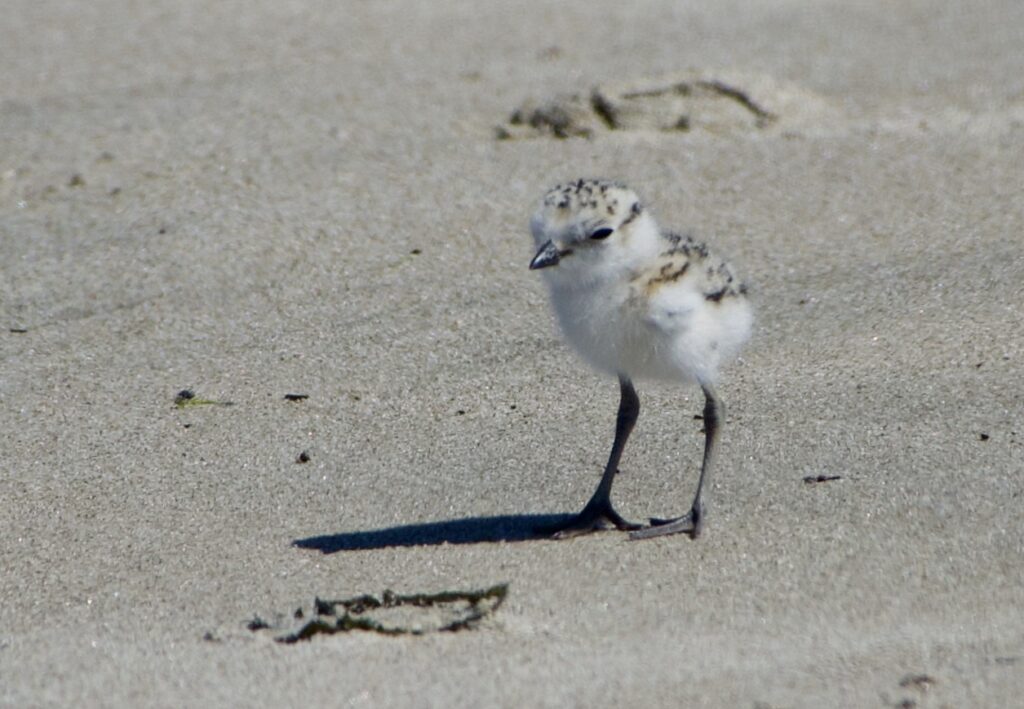
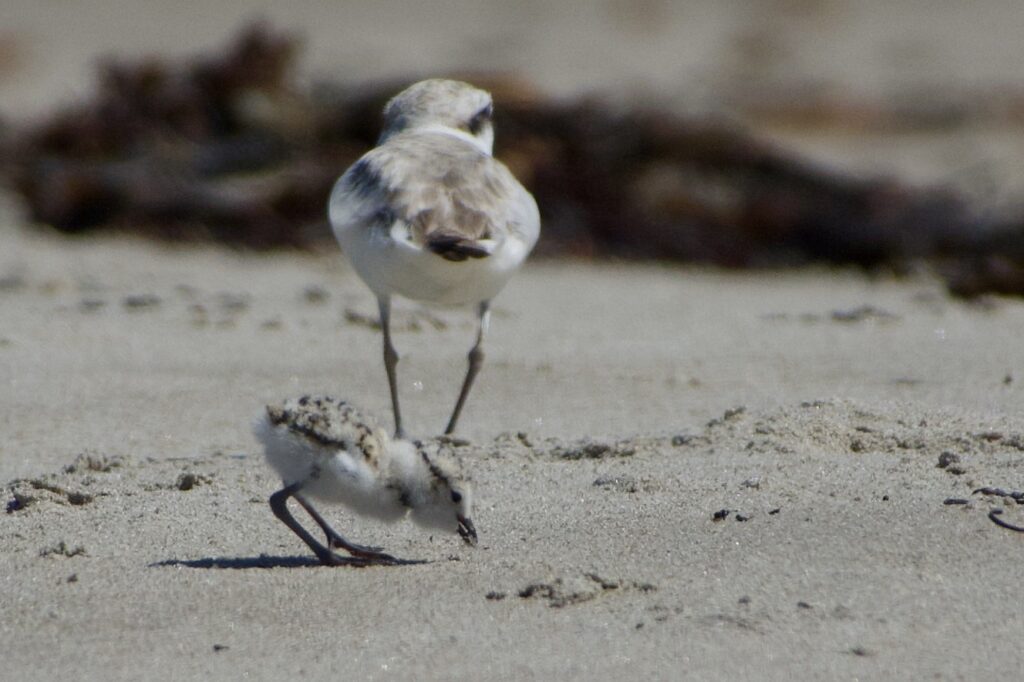

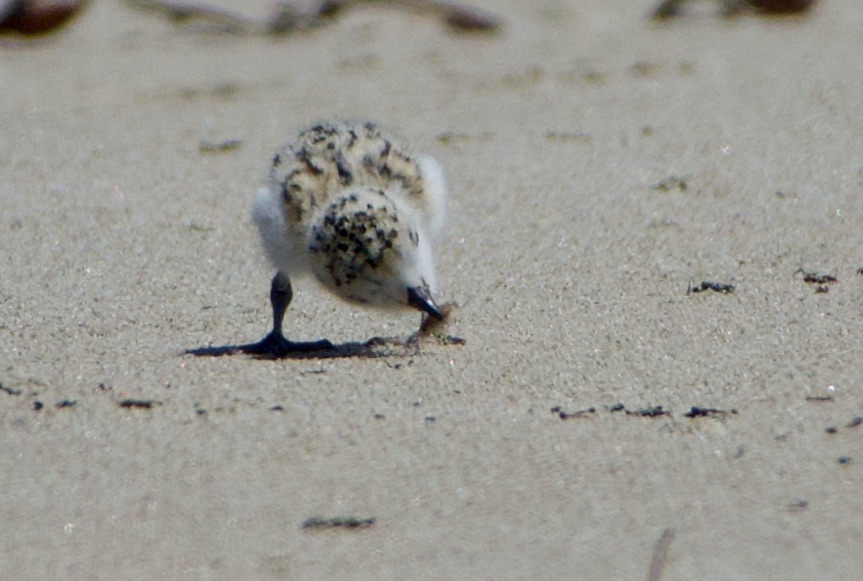
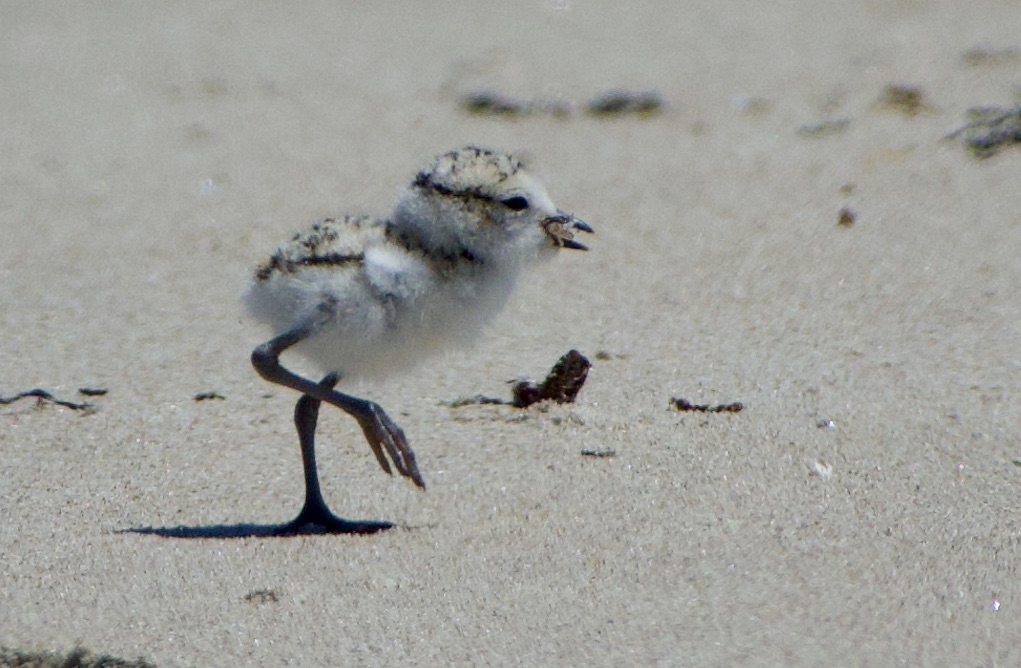

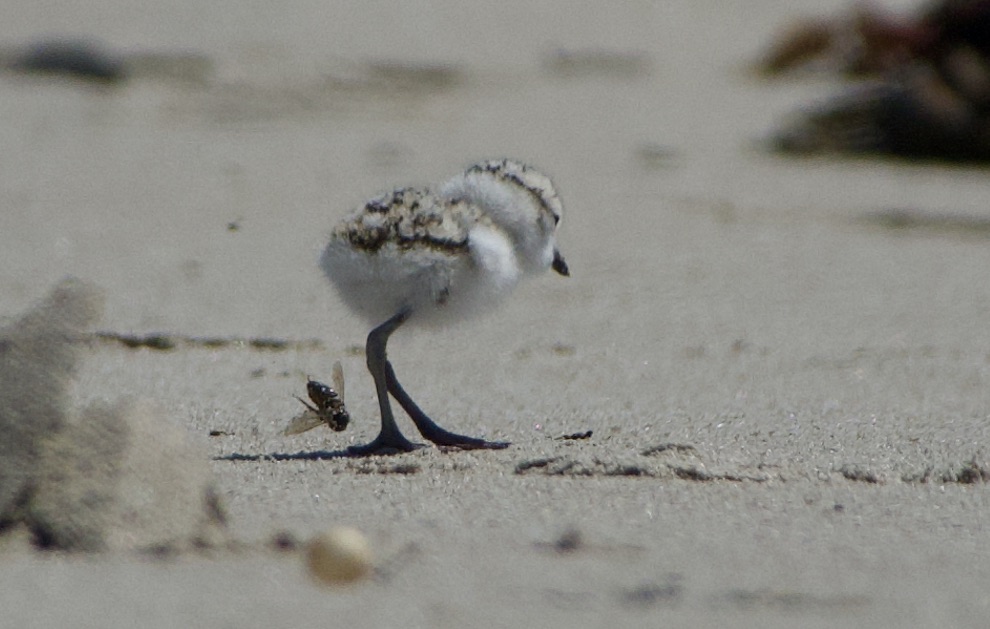
Sunday, June 13, 2021: The snowy plover family forages on the beach. State Parks staff and lifeguards watch over the area and do lots of outreach to lots of interested beachgoers. In the afternoon I take photos of the adult male staring down an interloping western gull and chasing off a Cassin’s kingbird. I also take a brief video of one of the chicks and the adult male foraging on the beach. (eBird list)
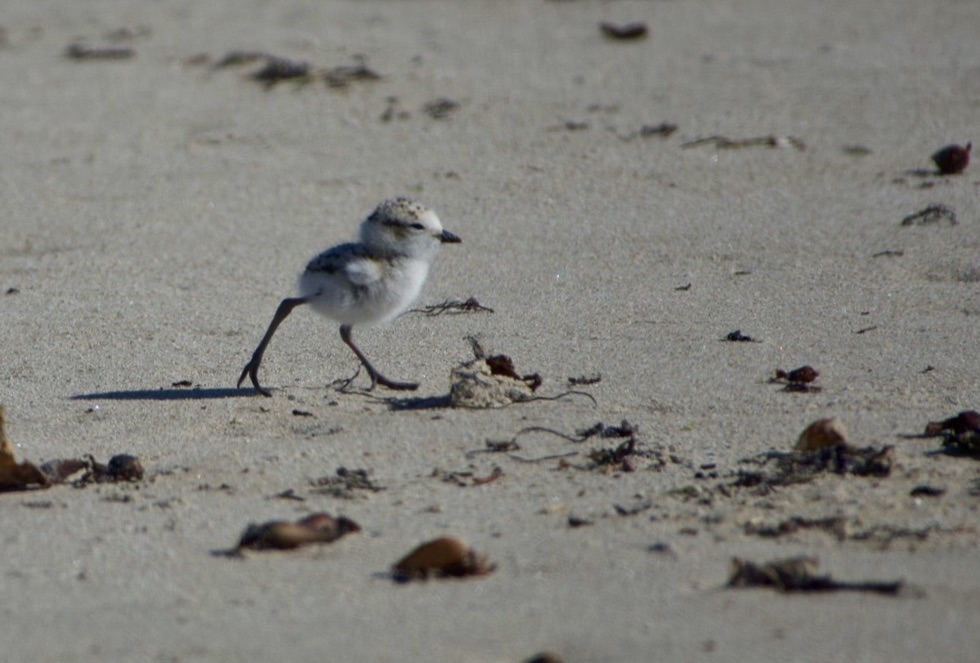
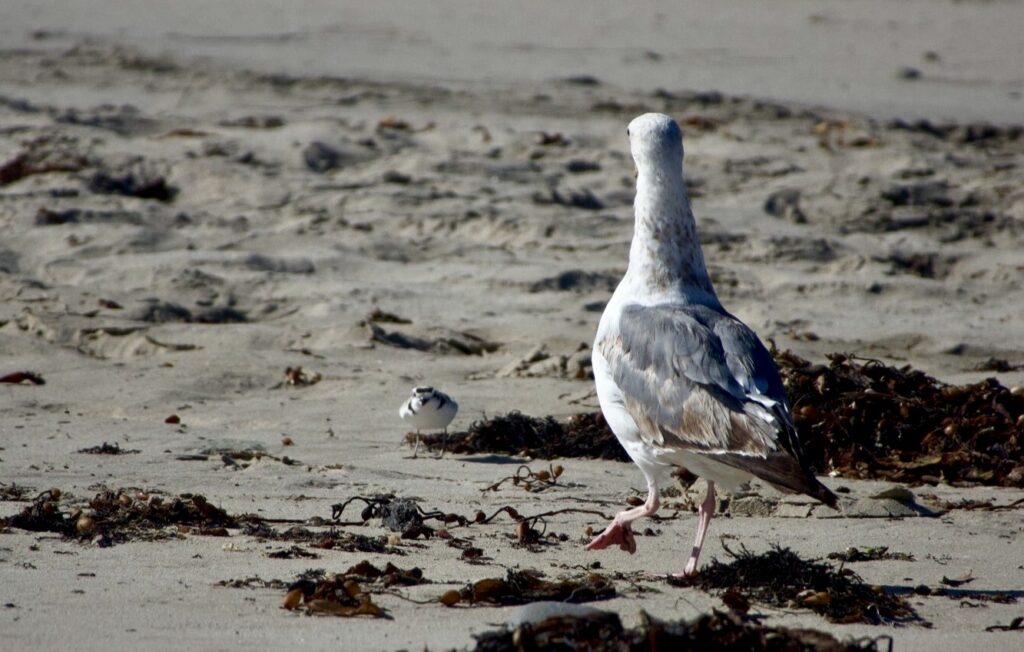
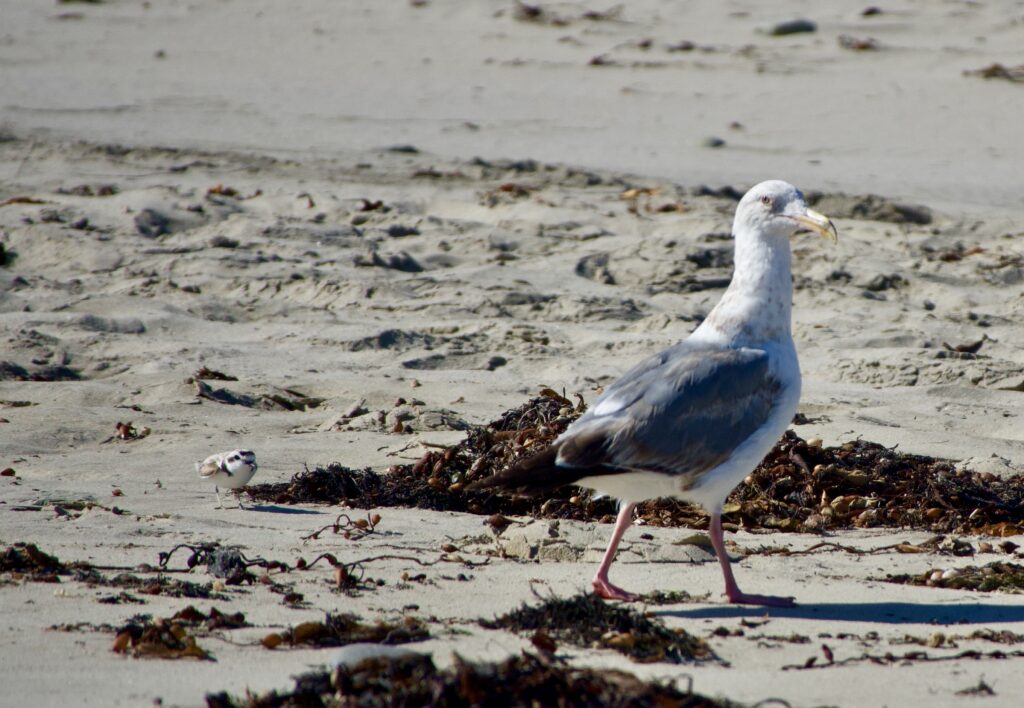
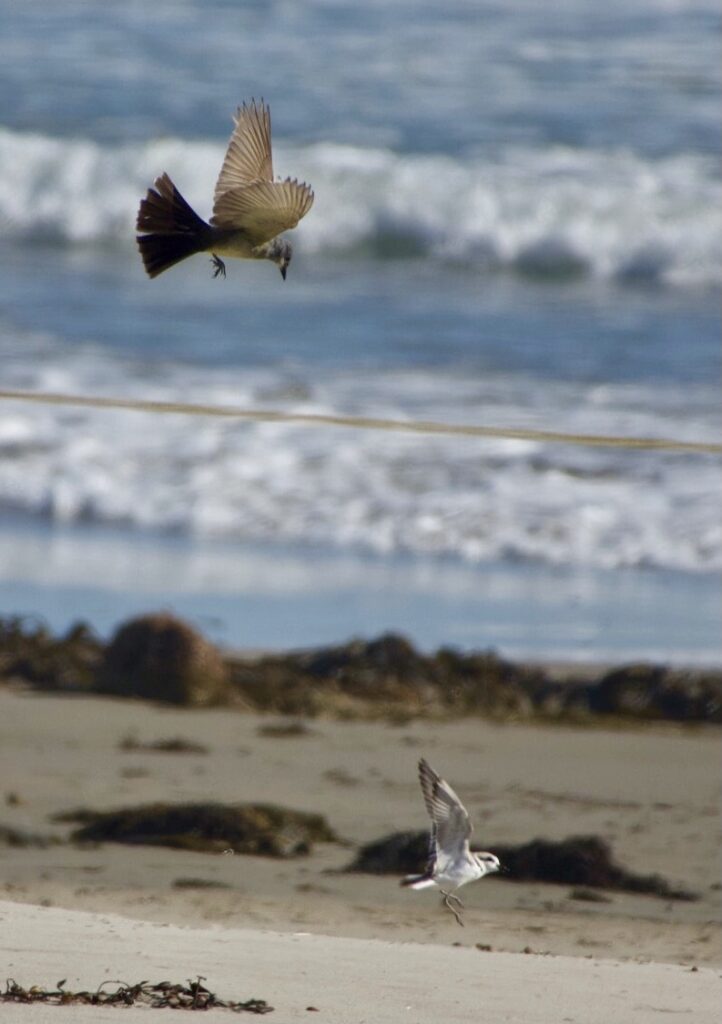
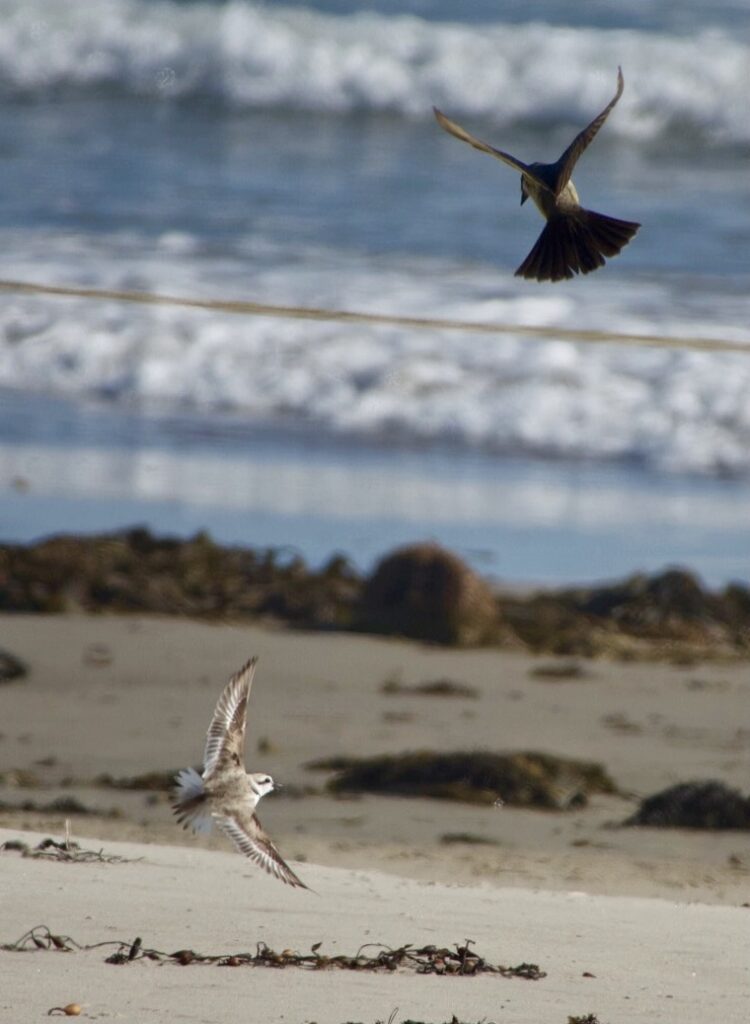
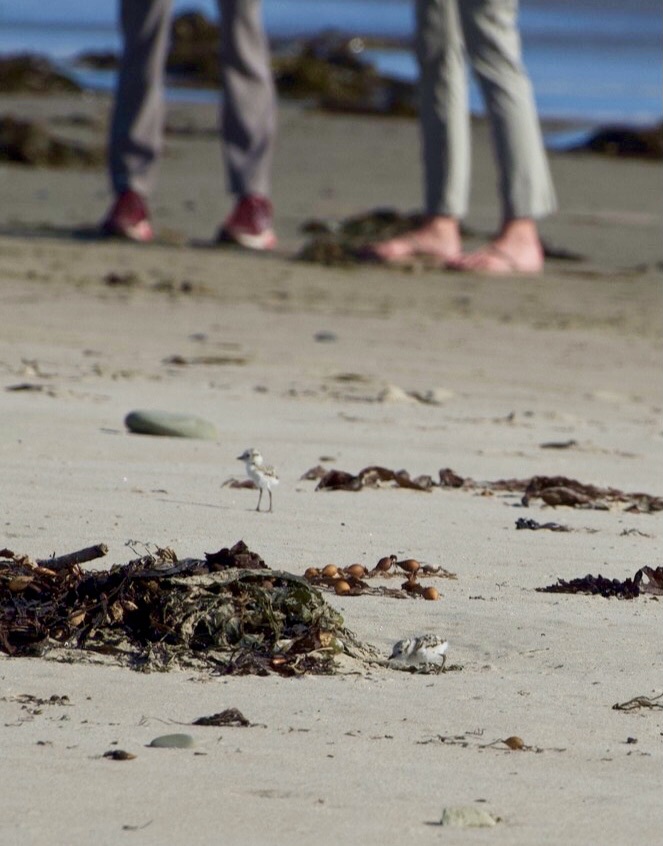
Monday, June 14, 2021: I visit the site in the afternoon. It’s a warm day, and when I visit the chicks are sheltering in the shade of the male bird (one chick) and under nearby dune vegetation (the other two chicks). Although I only see one of the chicks myself, April Randol is there as part of the State Beach presence monitoring the birds, and she confirms seeing all three birds. (eBird list)
Tuesday, June 15, 2021: I visit the site around 3:15 p.m. All three chicks are foraging actively at the edge of the wet sand with the adult male mostly watching. The beach is fairly crowded, but people are respecting the extended coned area and the birds seem mostly unconcerned by them. (eBird list)
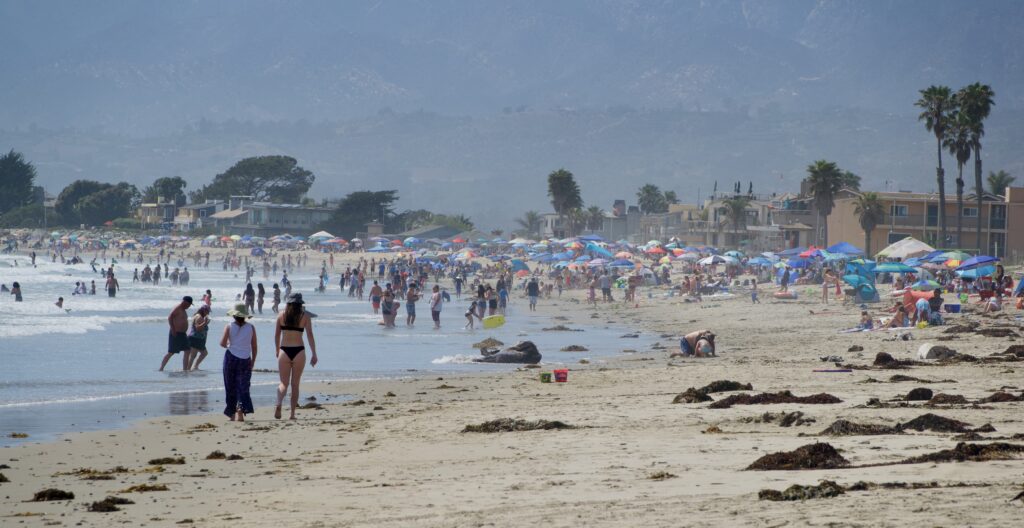
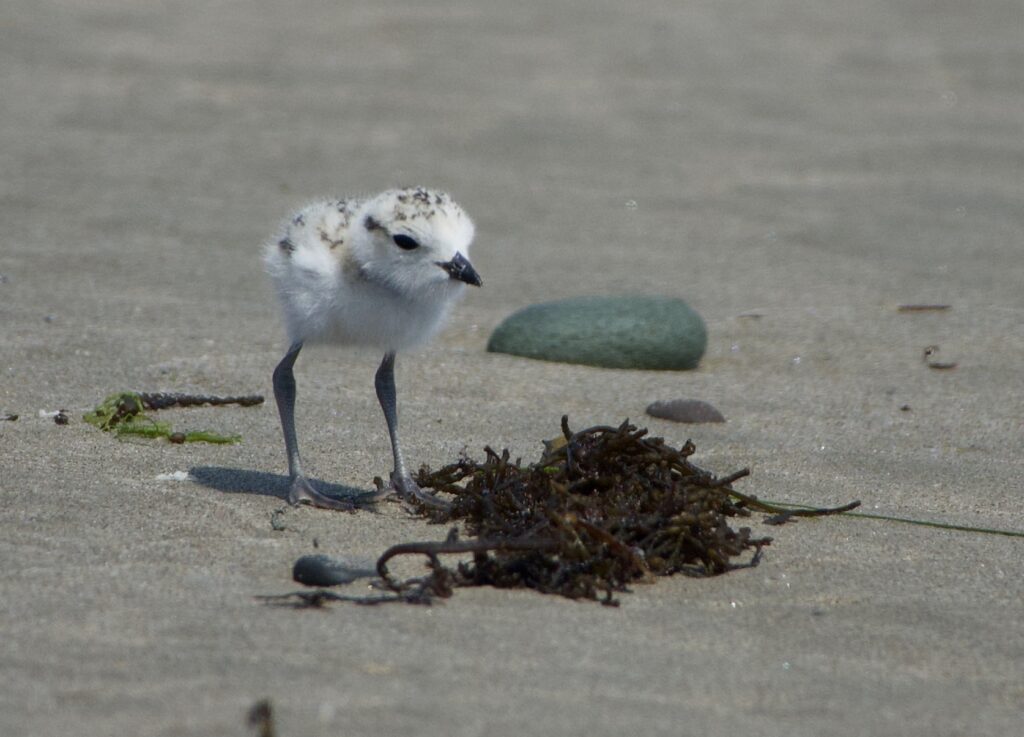
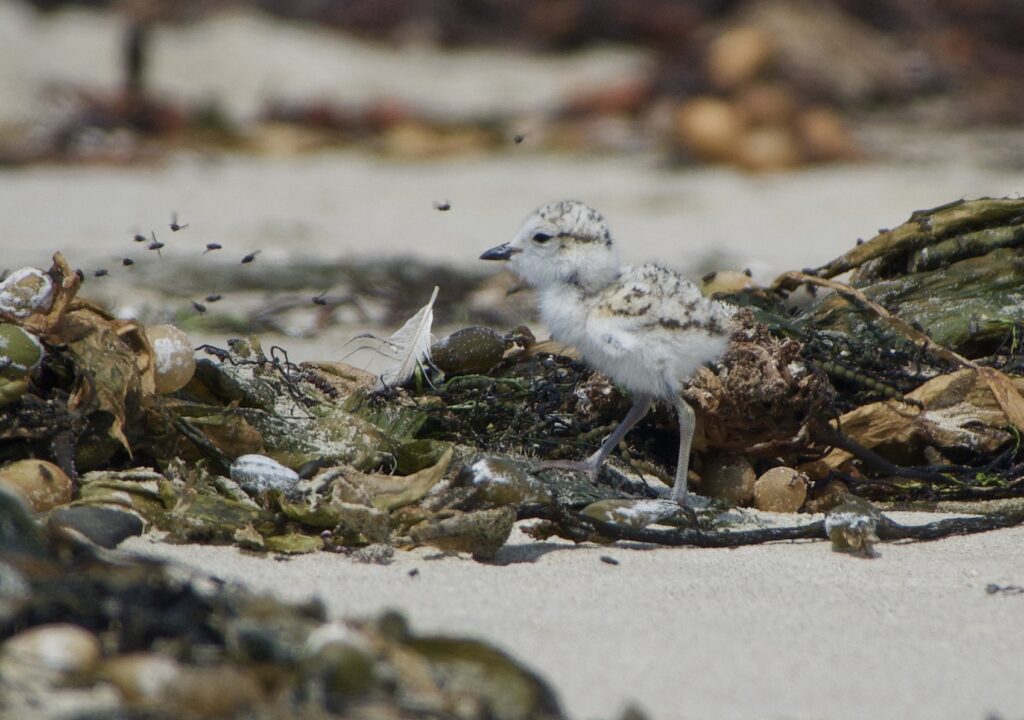
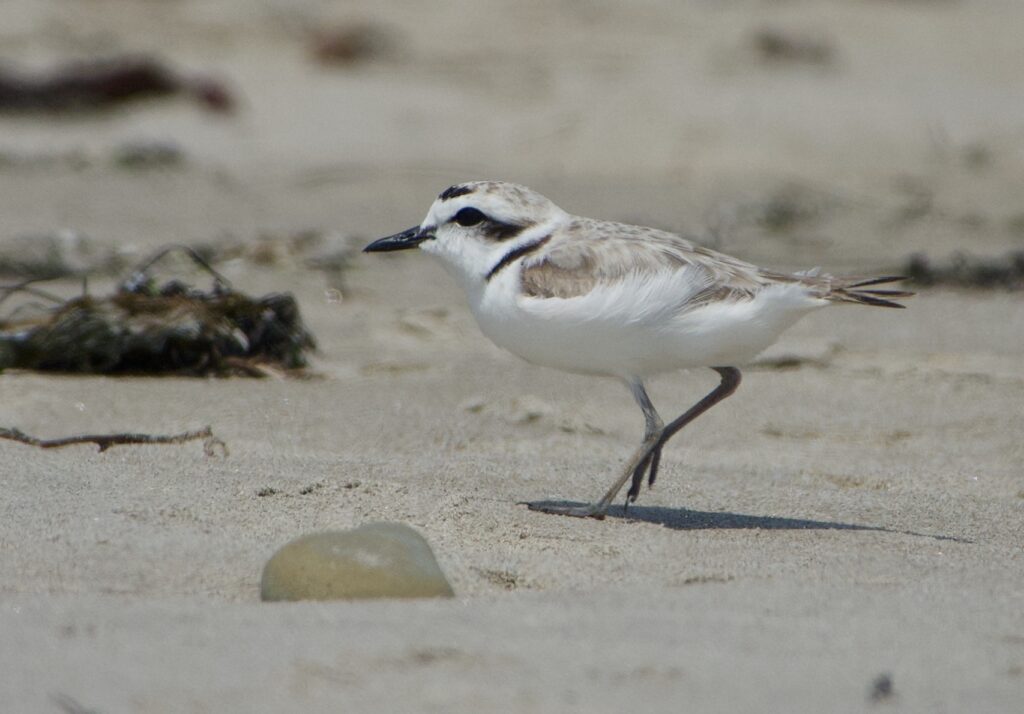
Wednesday, June 16, 2021: I observe the four birds starting around 6:30 a.m. The chicks alternate between huddling under the adult male for warmth and foraging in the wrack south of the roped-off area. I take a number of photos and a brief video. (eBird list)
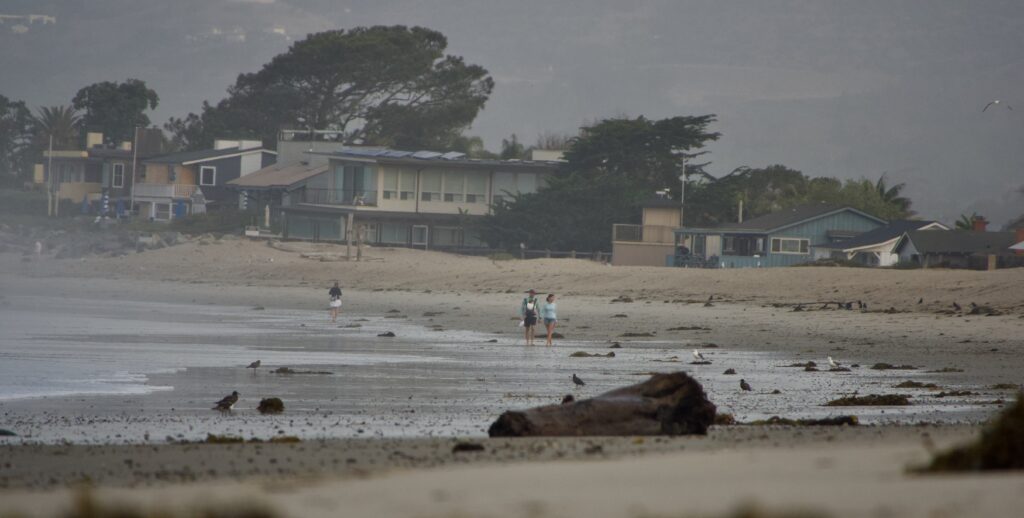
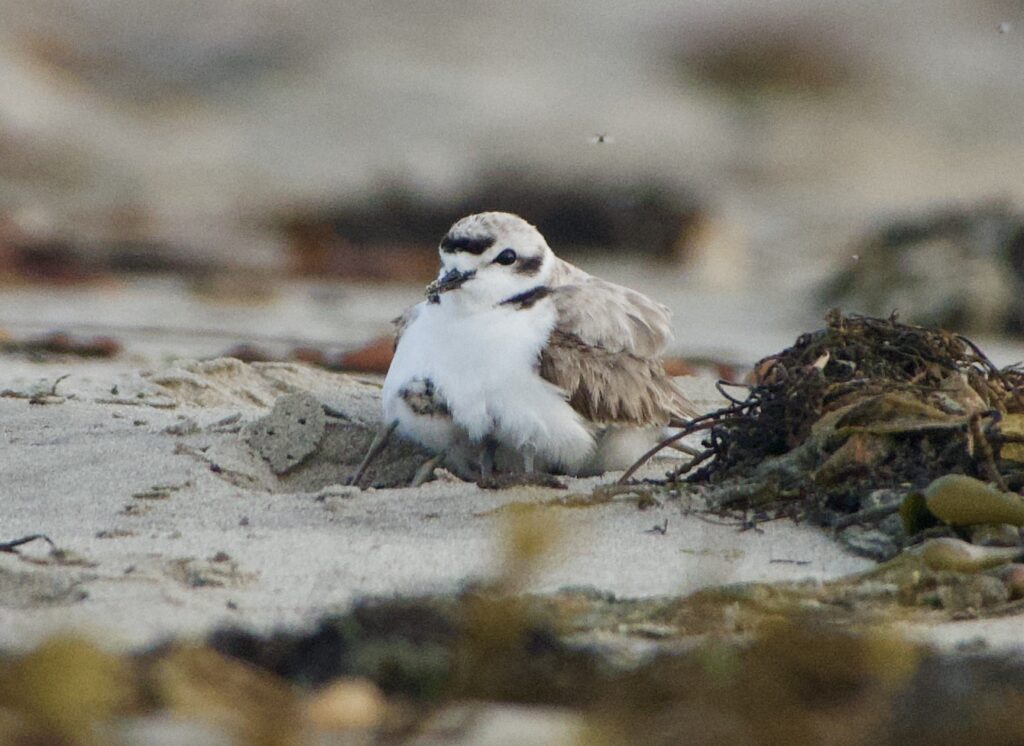
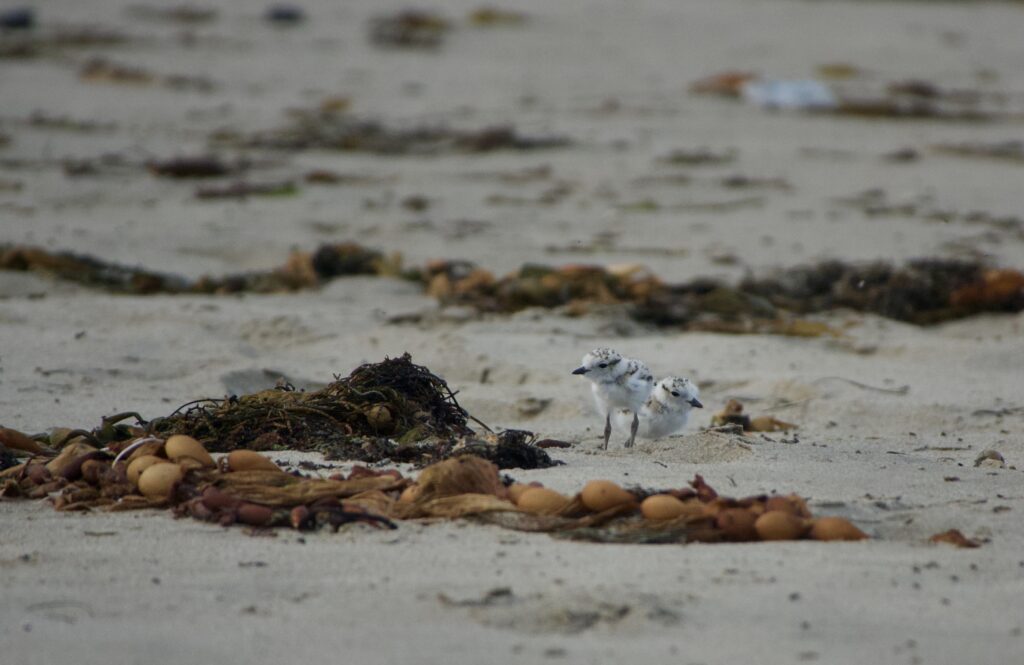
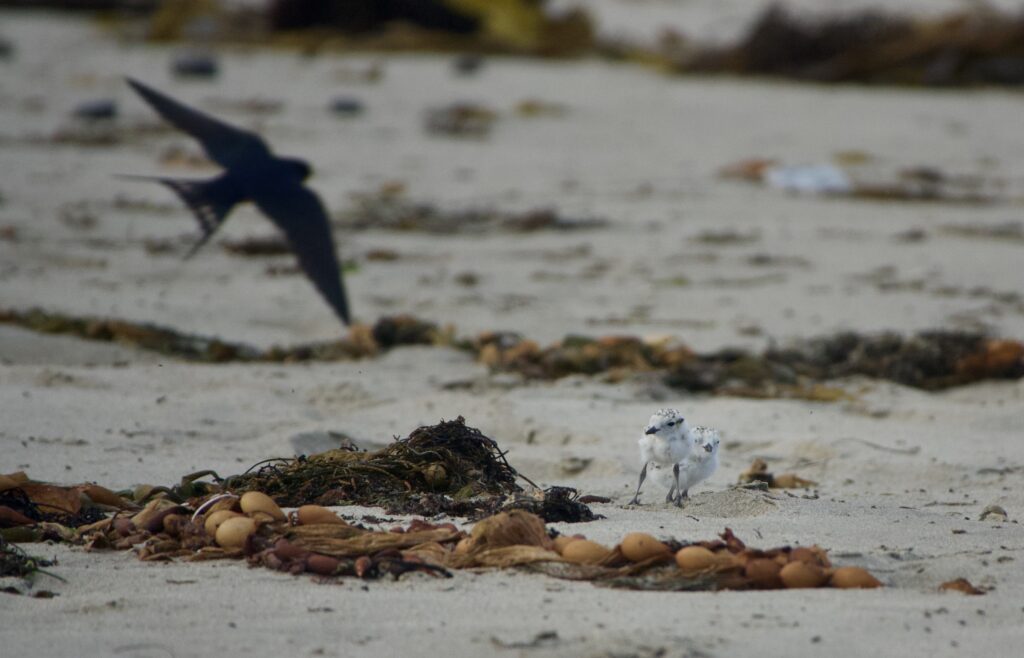
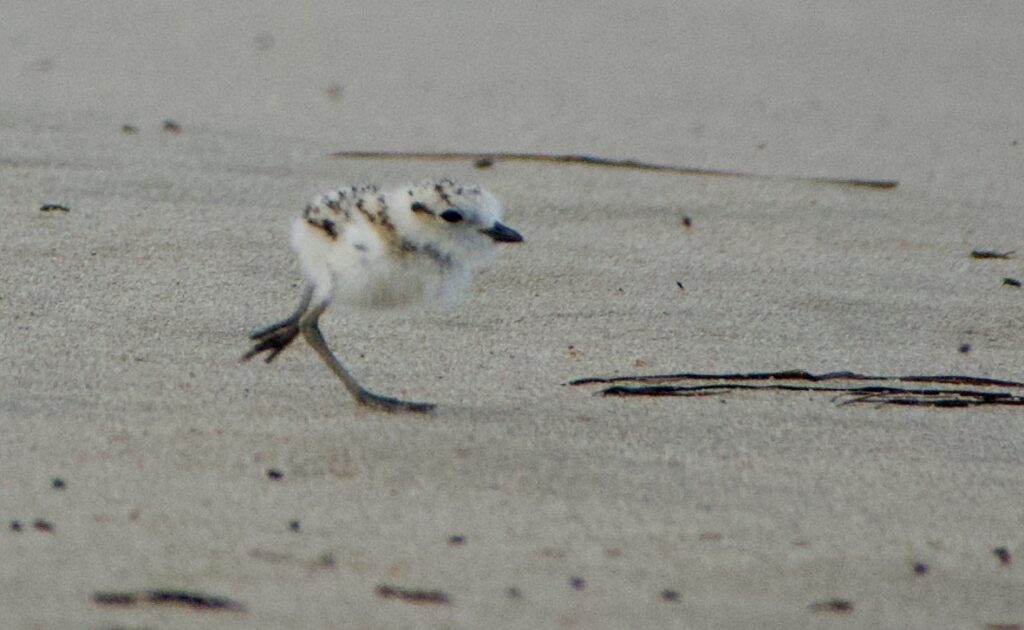
Libby Patten visits the site after 10:50 a.m. She sees not only the adult male and three chicks but also a fifth bird, which photos show to be pa:yb, the banded female bird that attempted nesting at the site a year ago (see discussion above). According to Jessica Nielsen pa:yb nested at Coal Oil Point this year, with the eggs hatching the previous Sunday, June 13. (eBird list)
Thursday, June 17, 2021: I visit the site in the afternoon and see the male and three chicks. I don’t see pa:yb. Brooke Sheridan (State Parks biologist) says that bird has not been seen in the area today. (eBird list)
Friday, June 18, 2021: Tom Beland visits the site and sees the adult male, the three chicks, and a fifth bird (an adult) that is driven off by the adult male. (eBird list)
Monday, June 21, 2021: Silvia Echeverria visits the site and sees an adult snowy plover and three chicks. (eBird list)
Wednesday, June 23, 2021: Seth Kastner visits the site and sees an adult snowy plover and three chicks. (eBird list)
Thursday, June 24, 2021: We talk about the Carpinteria snowy plovers at the June Zoom meeting of Carpinteria Birdwatchers.
Saturday, June 26, 2021: I visit the site in the late afternoon and see the adult male and three chicks resting in the roped-off area. (eBird list)
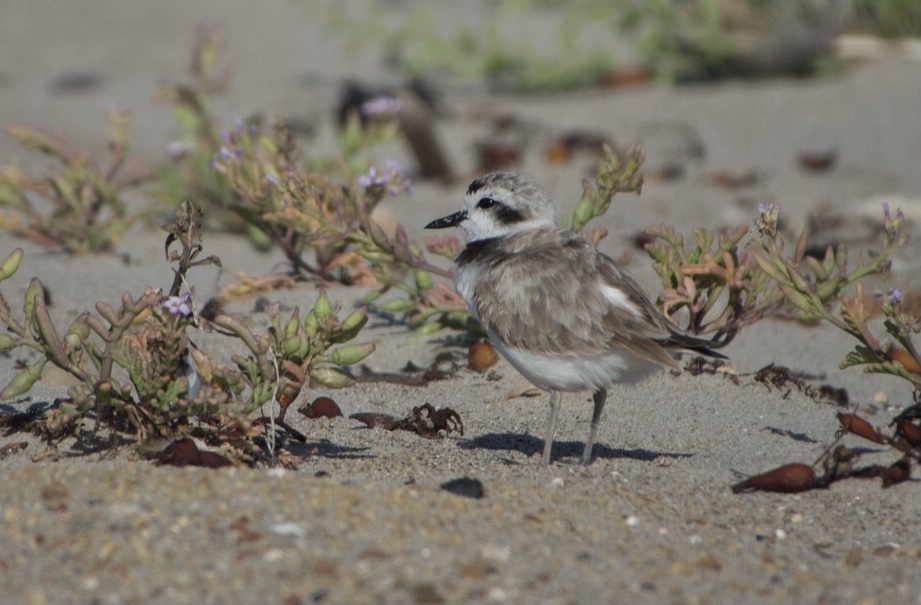
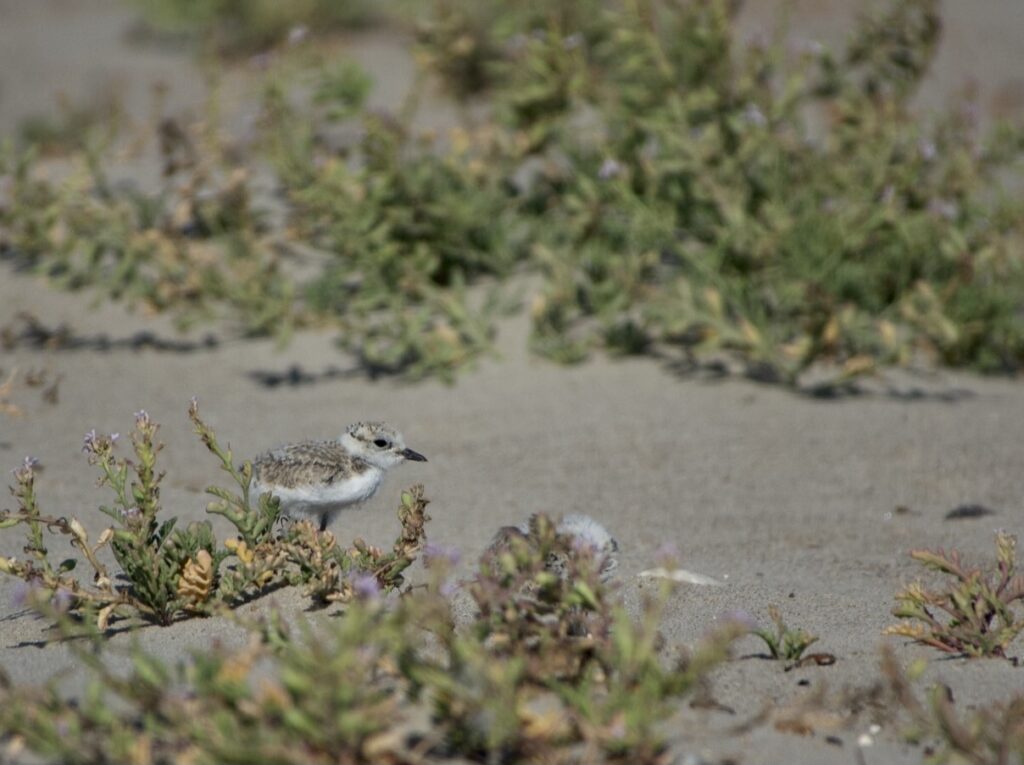
Monday, June 28, 2021: I visit the site in the early morning and see the adult male and three chicks outside the southwest corner of the roped-off area. (eBird list)
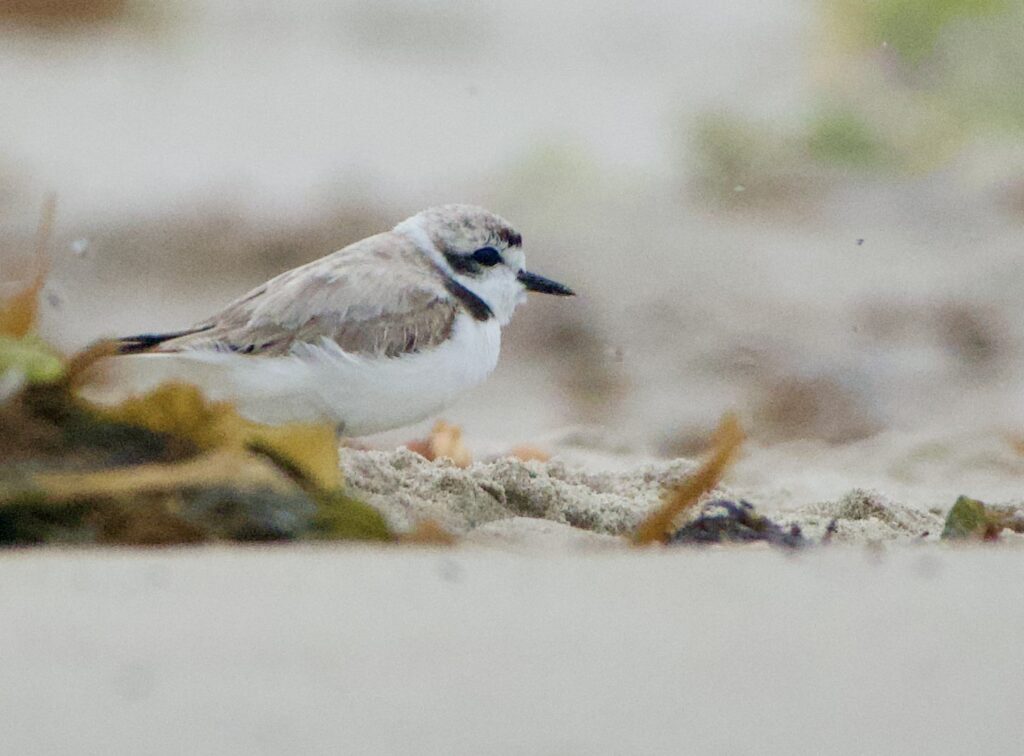
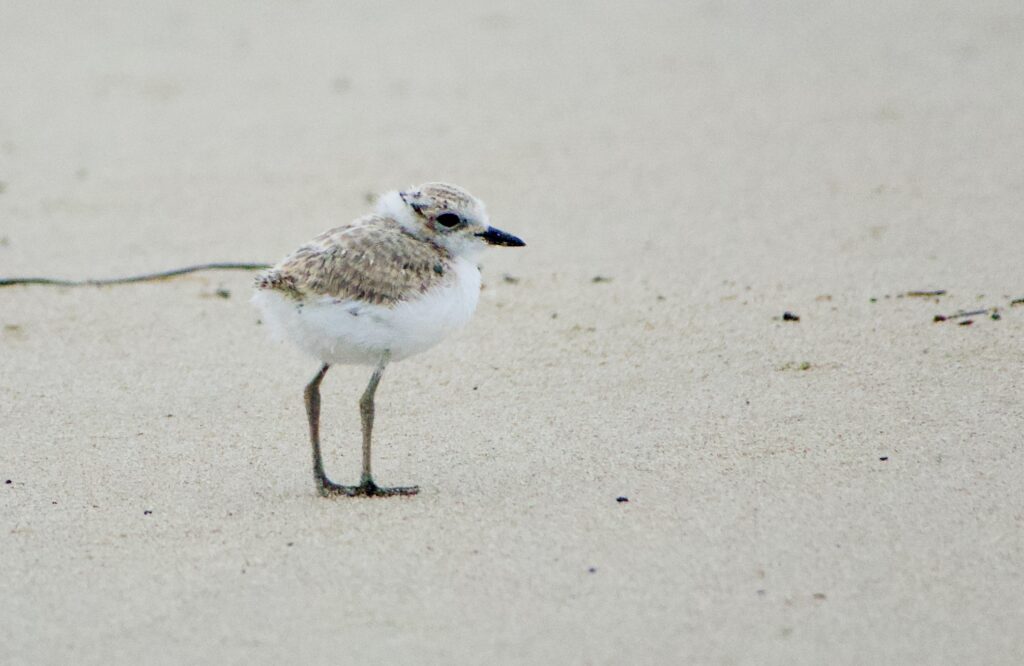
Tuesday, June 29, 2021: I visit the site in the morning and photograph the adult male and three chicks foraging near the water’s edge. At one point the adult male uses a distraction display on a nearby Heermann’s gull. (eBird list)
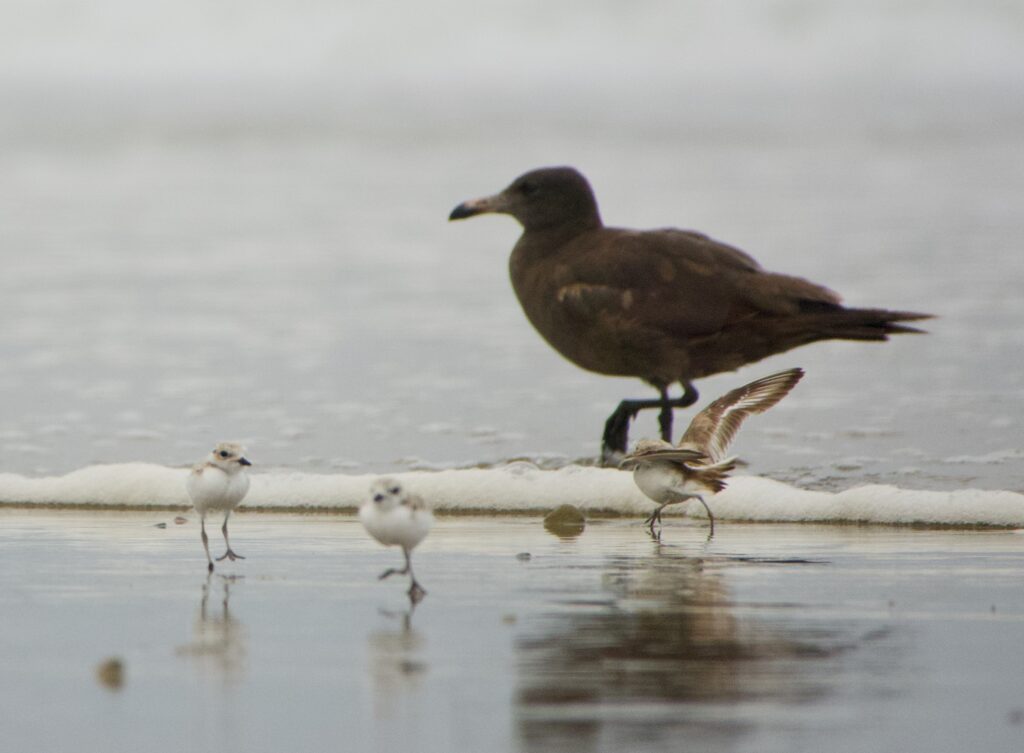
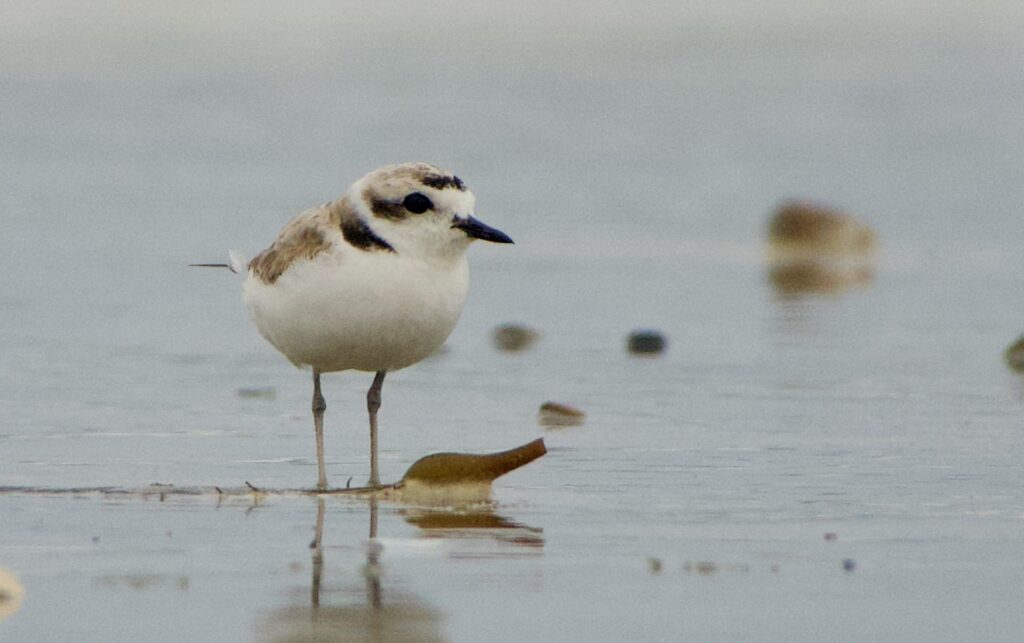

Wednesday, June 30, 2021: I visit the site in late afternoon and observe the adult male and three chicks resting in the dune vegetation inside the roped-off area. (eBird list)
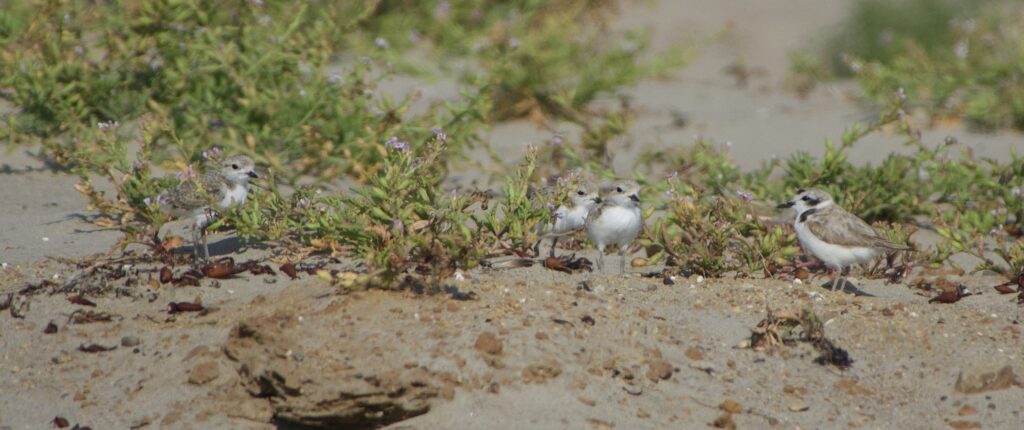
Thursday, July 1, 2021: I observe the adult male and three chicks near the middle of the day. One of the chicks is bathing in a puddle near the water’s edge doing lots of wing-flapping. (eBird list)
Saturday, July 3, 2021: Carpinteria Birdwatchers members visit the plovers in the morning during our first in-person group outing since the start of the pandemic. (eBird list)
Wednesday, July 7, 2021: I visit the site in the morning and see what appears to be an unattached adult snowy plover, then later I see the three chicks a short distance down the beach, and then the adult male with them. After looking at photos I believe the first bird I saw was probably the adult male. A person fishing along the beach talks with me about the plovers and tells me that the previous day his wife observed one of the fledglings fly a few feet. (eBird list)
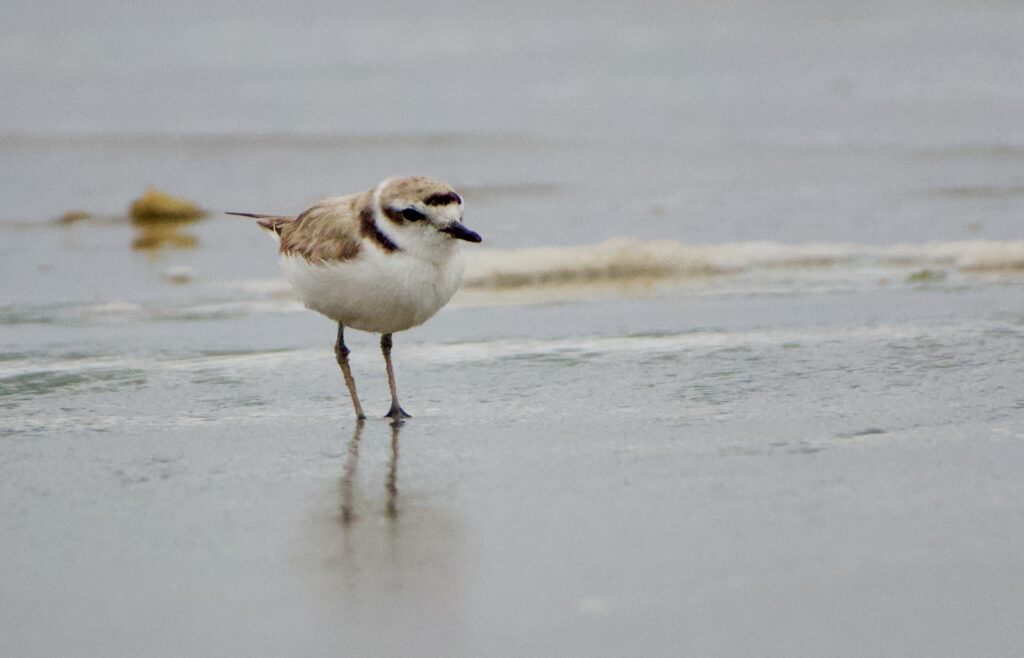

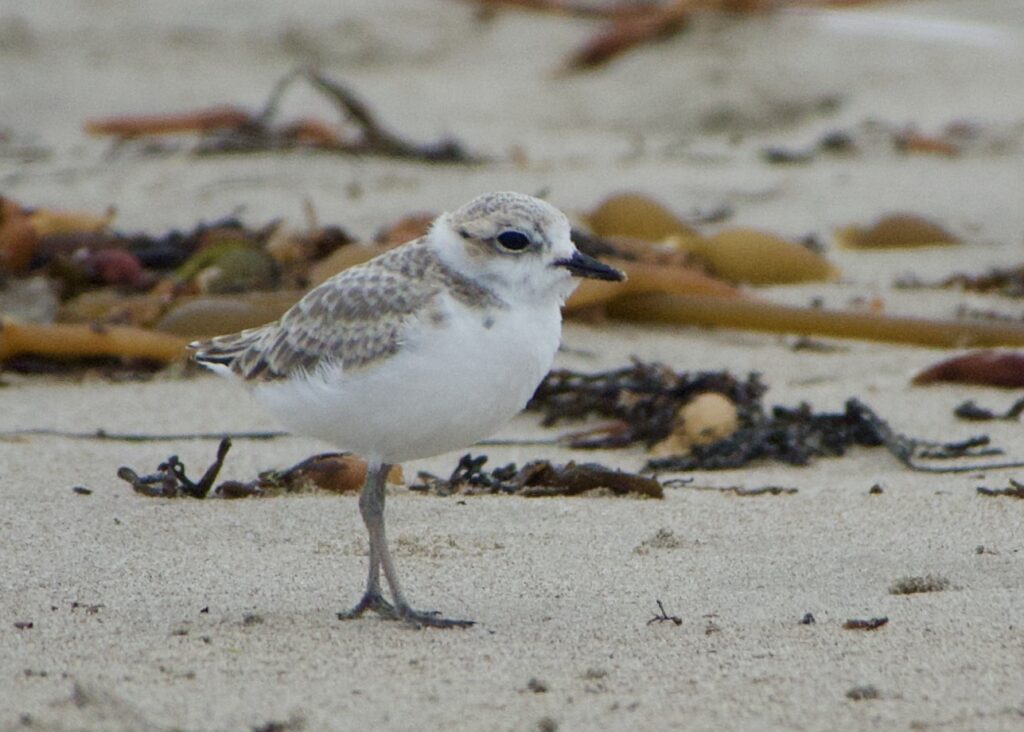
Thursday, July 8, 2021: I visit the site in the morning and observe the adult male and the three chicks. (eBird list)
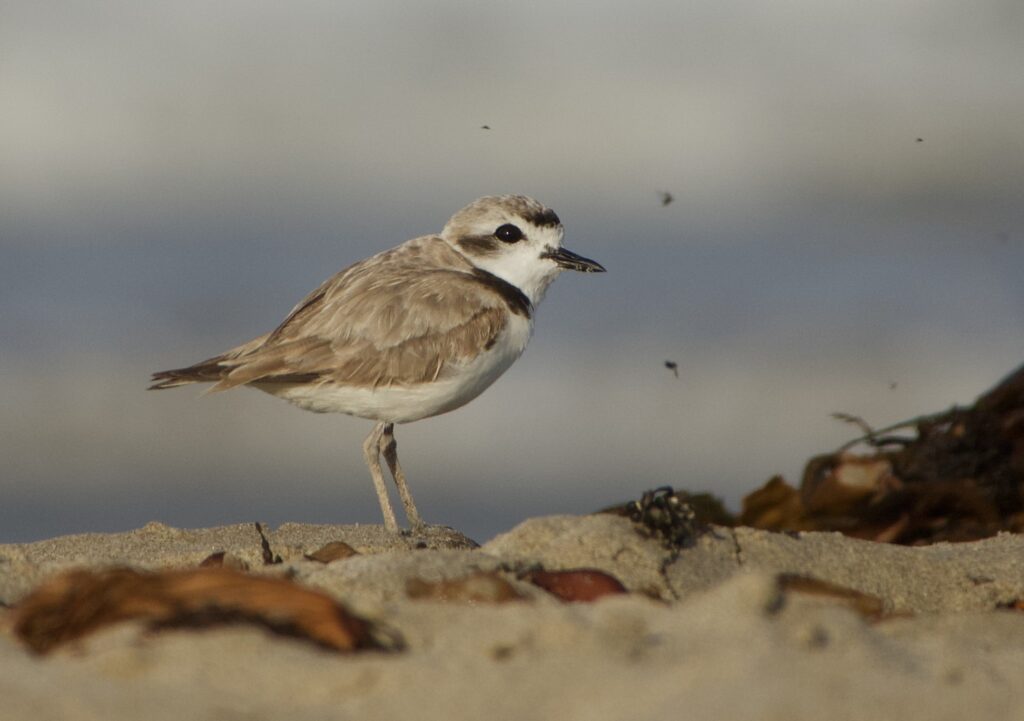
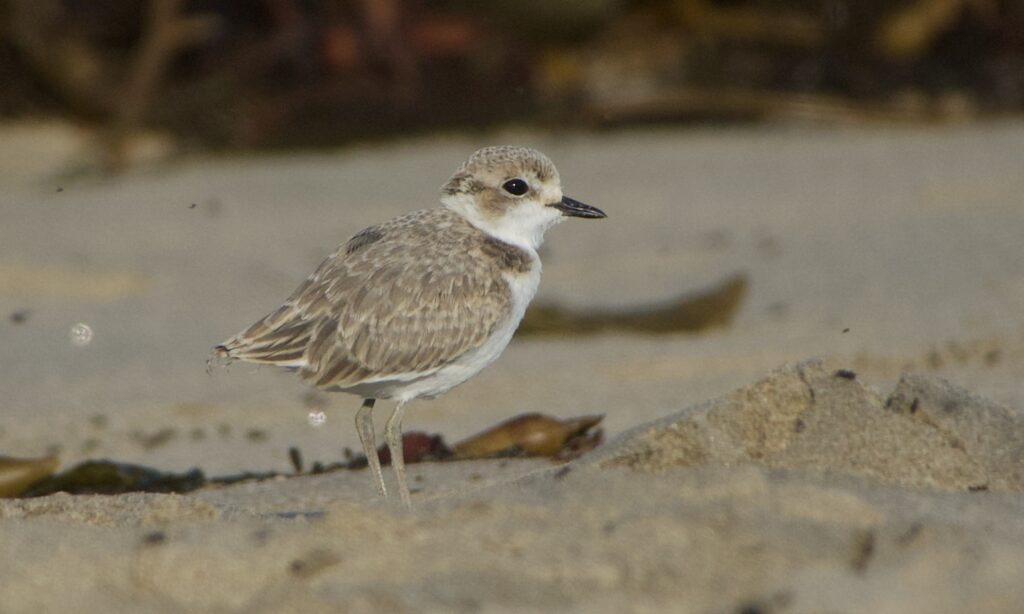
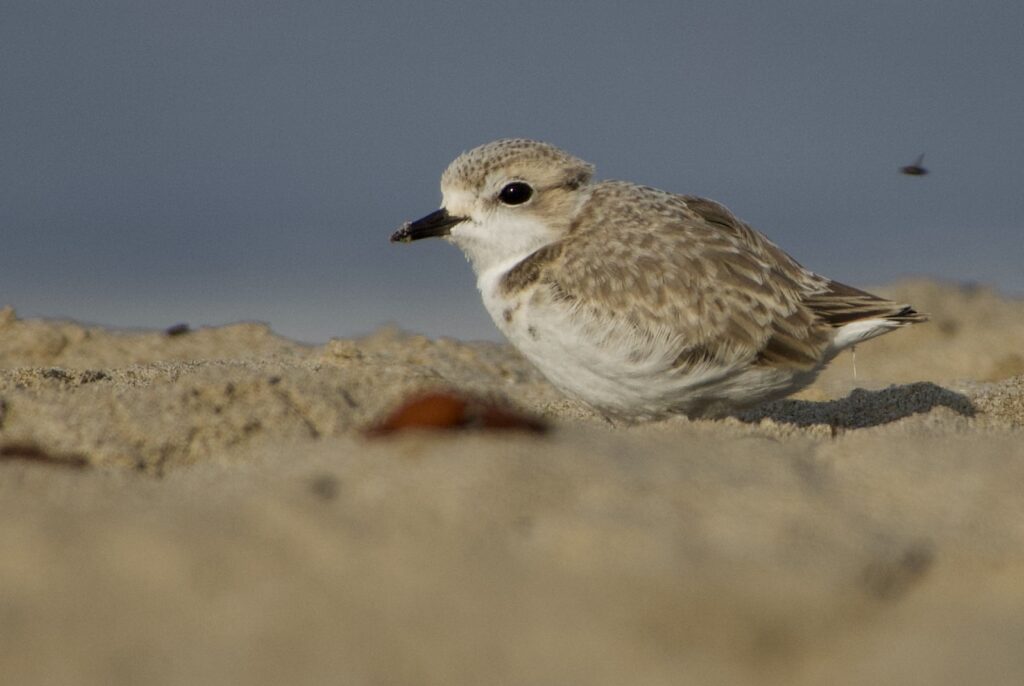
I also shoot a short video of the birds, including one brief moment when one of the chicks uses its wings to help it make a quick hop through the air.
After visiting the nearby black oystercatcher nest site, I visit the plovers again on my return walk and take a few more photos. (eBird list)

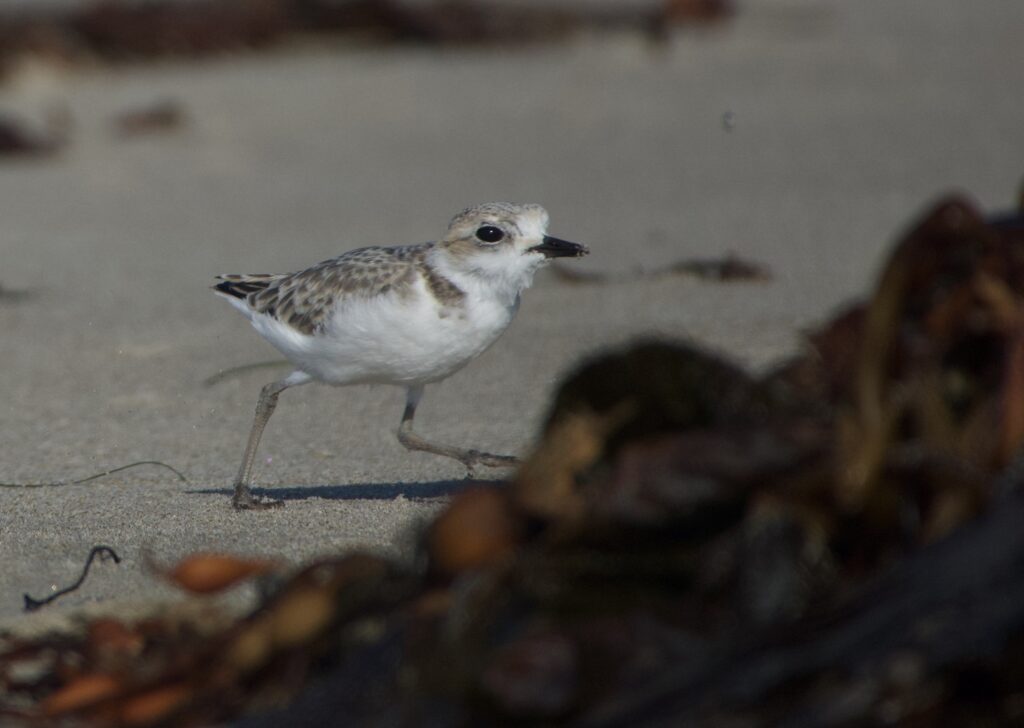
Friday, July 9, 2021: I visit the site in the afternoon and see the adult male and three fledglings. While I’m watching I see two of the fledglings take short flights of a few feet. (eBird list)
I shoot a brief video.
Saturday, July 10, 2021: Two people who visit the site subsequently tell me they only saw the adult male and two fledglings.
Sunday, July 11, 2021: I visit the site in the morning and see the adult male and two fledglings. Although I spend roughly 45 minutes observing the birds I never see the third fledgling. At one point I see one of the fledglings fly about 10 feet across the sand. (eBird list)
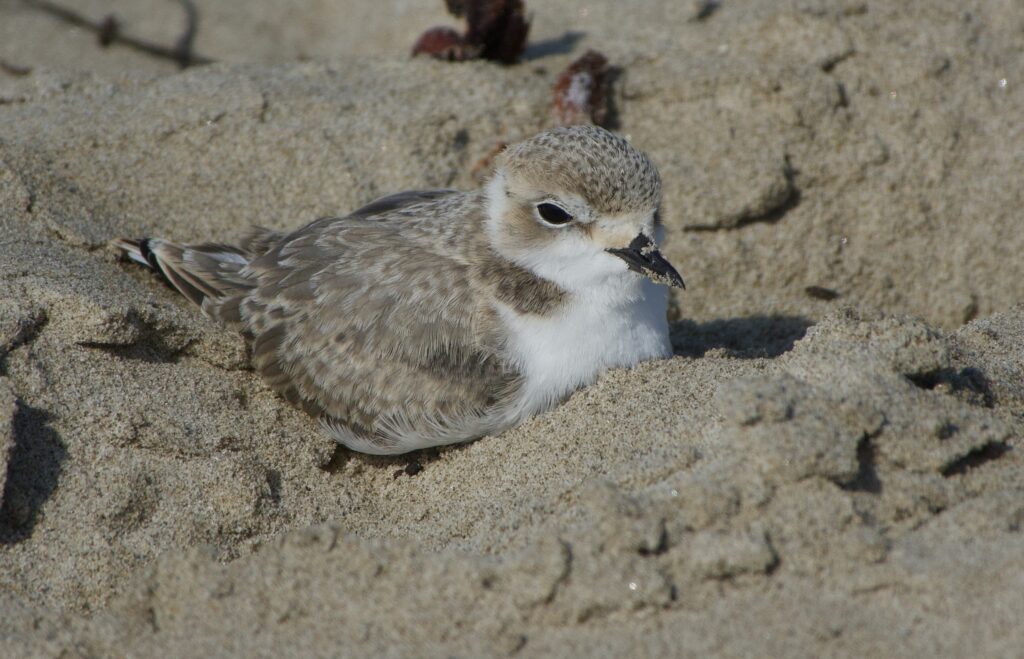
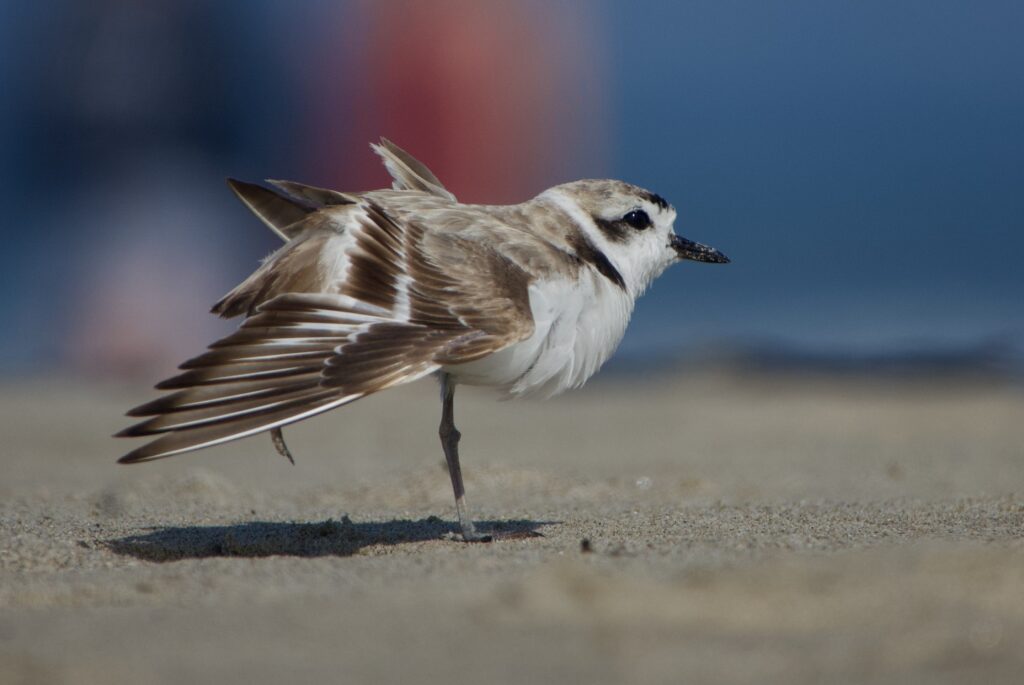
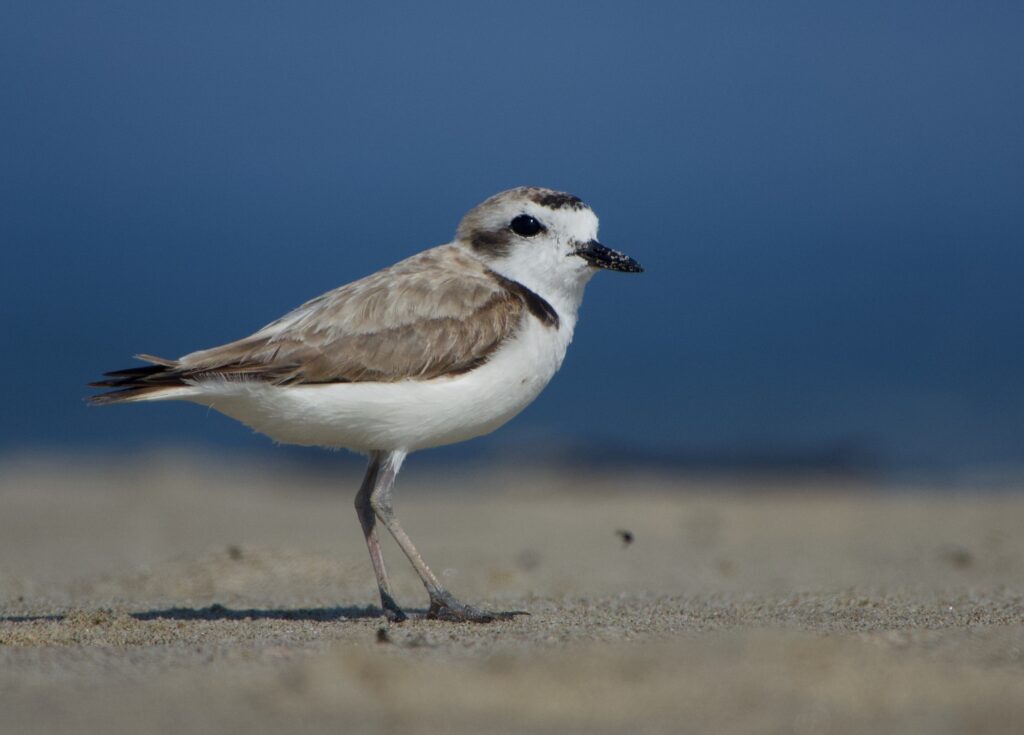
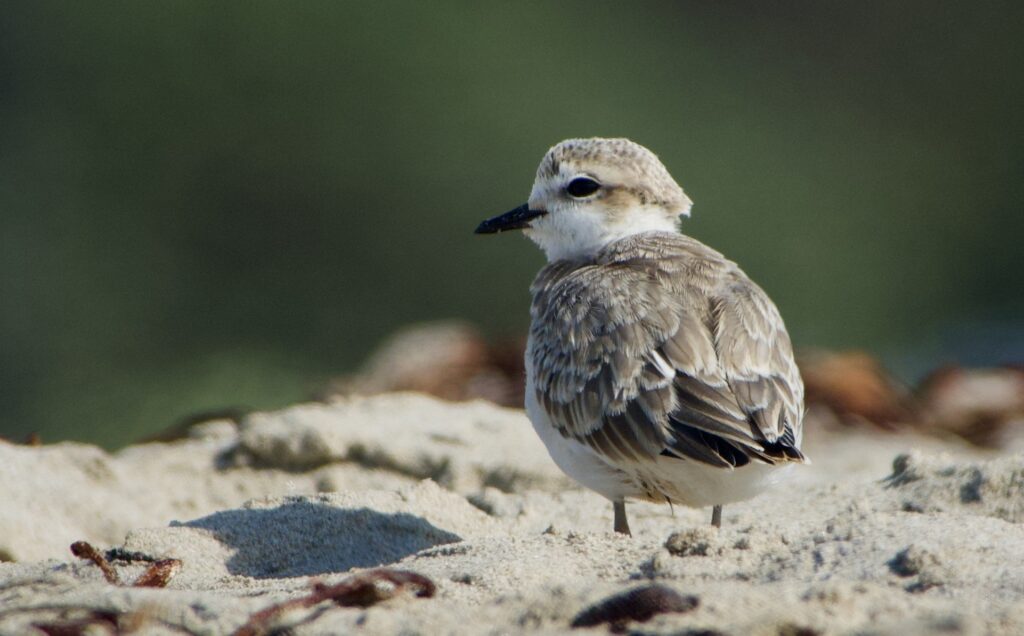
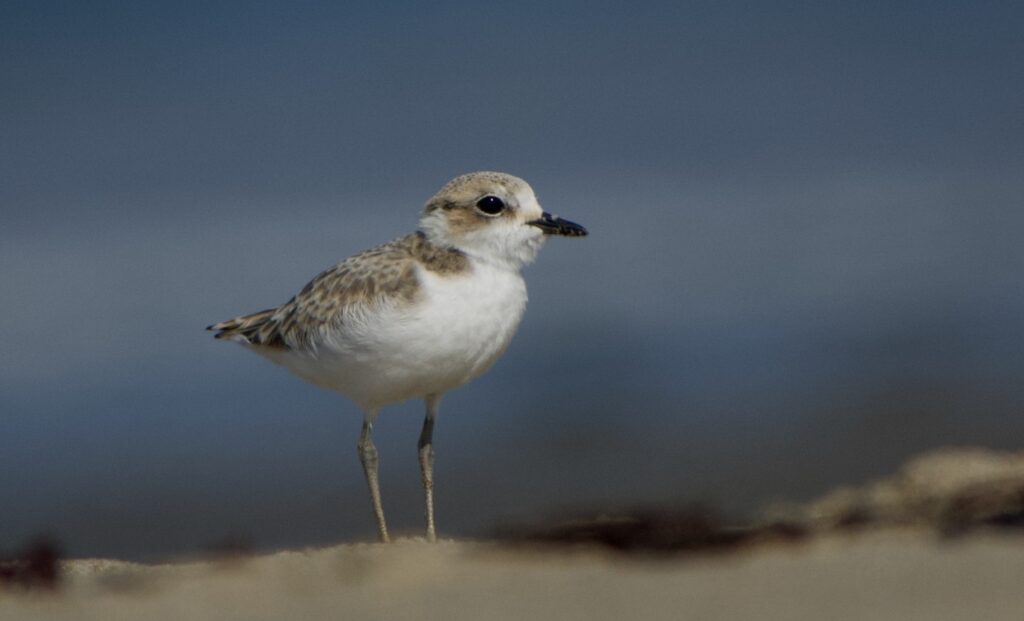
I shoot a brief video of one of the fledglings.
It’s hard to know if the third chick left on its own, or was a victim of an accident or predation. I’m inclined to be optimistic, and think it simply left the area.
Tuesday, July 13, 2021: I visit the site at 1 p.m. A large group of people have set up 5 awnings in a row near the southwest corner of the roped-off area; I’m unable to find any snowy plovers nearby or in either direction for several hundred yards along the beach. The birds apparently have moved on. (eBird list)

Wednesday, November 17, 2021: I give a talk to Santa Barbara Audubon on the Carpinteria Snowy Plovers. The video archive of that presentation is here:
Afterword
When I first learned about the nest I didn’t think the plovers would be successful. Gulls and crows are common in the area. There were so many people on the beach, and with the Memorial Day and Fourth of July holidays coming there were going to be hundreds, maybe thousands, more. It just didn’t seem reasonable that a pair of tiny birds laying their eggs in a shallow scrape in the middle of all that would be able to make it.
During one of our Carpinteria Birdwatchers meetings I asked Jessica Nielsen of Coal Oil Point what she thought the birds’ chances were. “I think they’ve got a pretty good chance,” she said, and in hindsight she was right. The Carp snowy plovers pulled it off. While there’s some uncertainty about the third chick having survived to fledging, I think it probably did, and just left the site a few days before its siblings.
I had a lot of fun watching this plover family. I learned a lot about them, including about their resilience in the face of human disturbance.
I was impressed by how much people were willing to help them. The State Park biologists who work on the plover recovery program are very busy up and down the coast during the nesting season, but they made the Carp nest a priority, and spent many days at the site. Park rangers, lifeguards, and local birdwatchers helped too. Campers and beachgoers, once they knew what was going on, were really good about shifting their activities a few yards down the beach.
The plovers really don’t need that much. People can still use, and enjoy, the beach. Just give the birds some washed-up kelp and a little space; they’ll do the rest.
1 thought on “The Carpinteria Snowy Plovers: An Illustrated Timeline, 2019–2021”
Comments are closed.